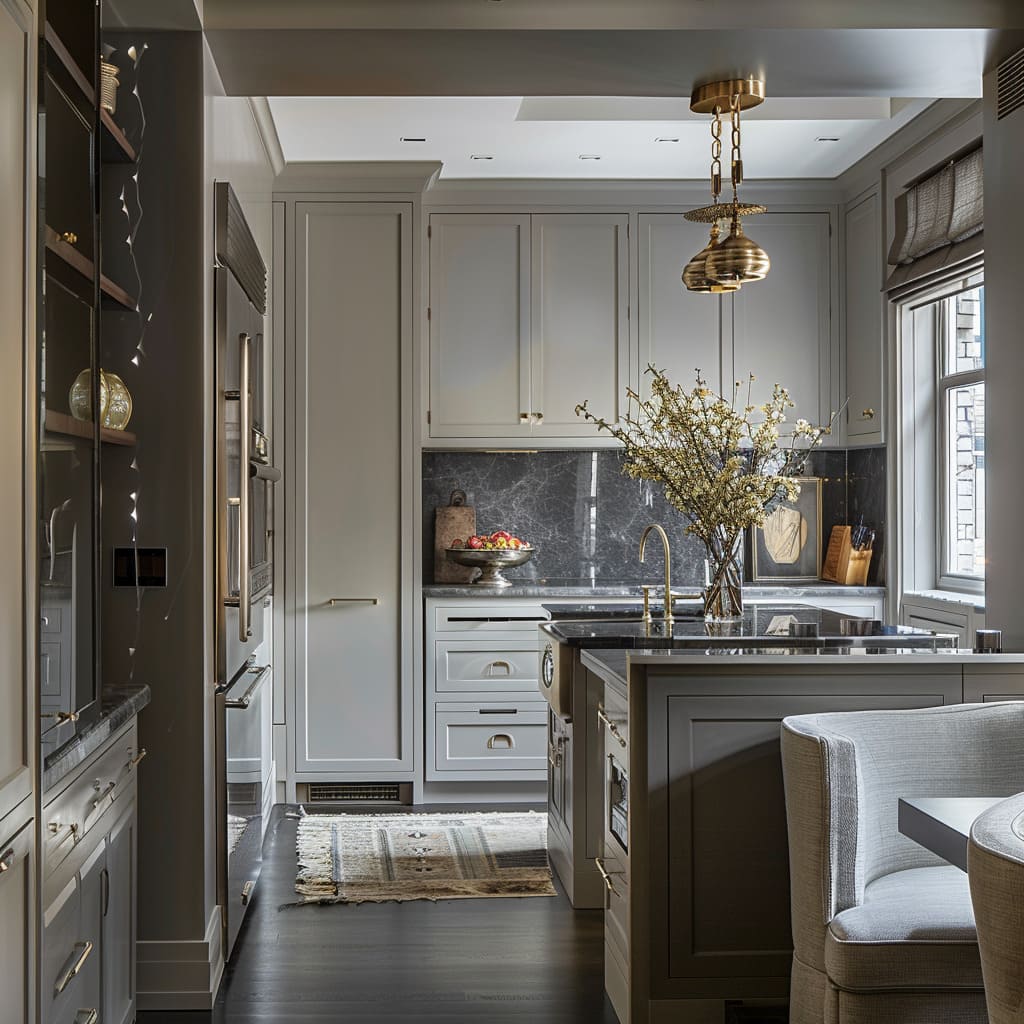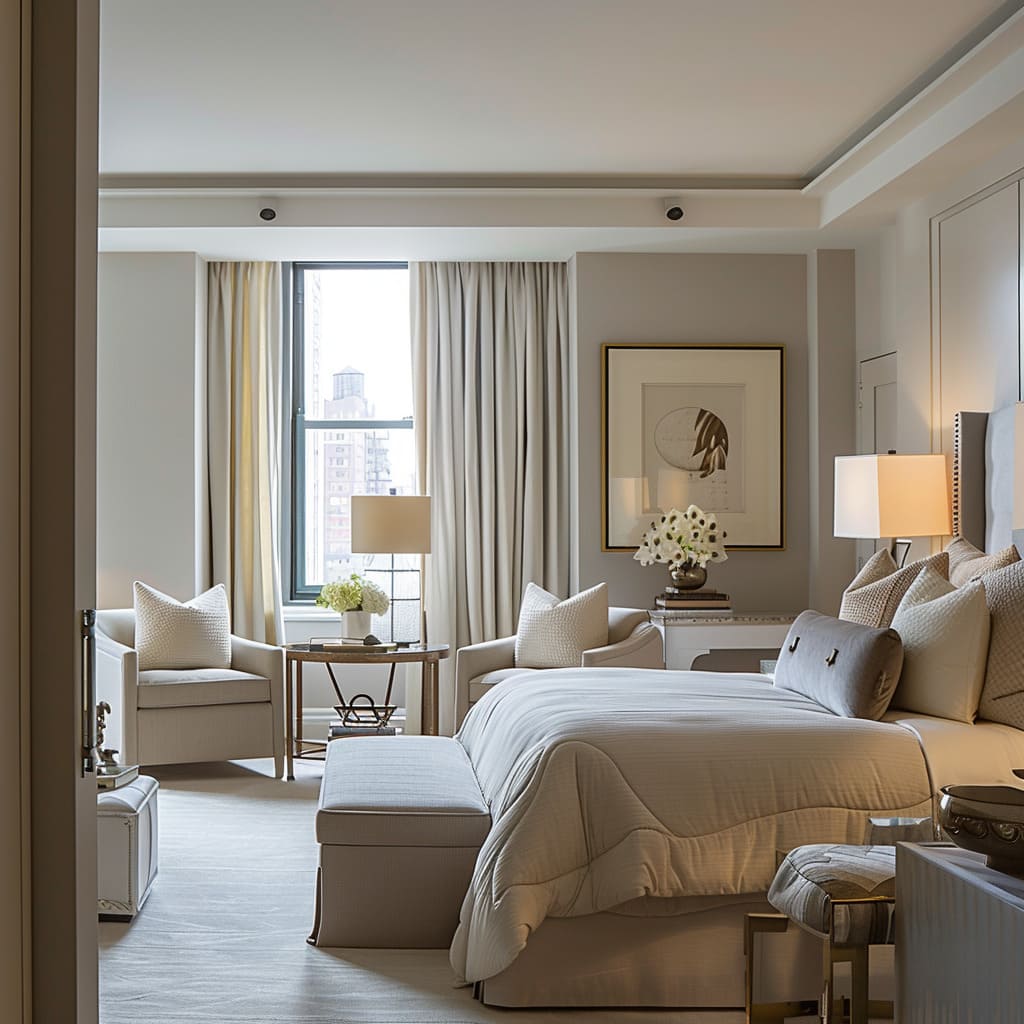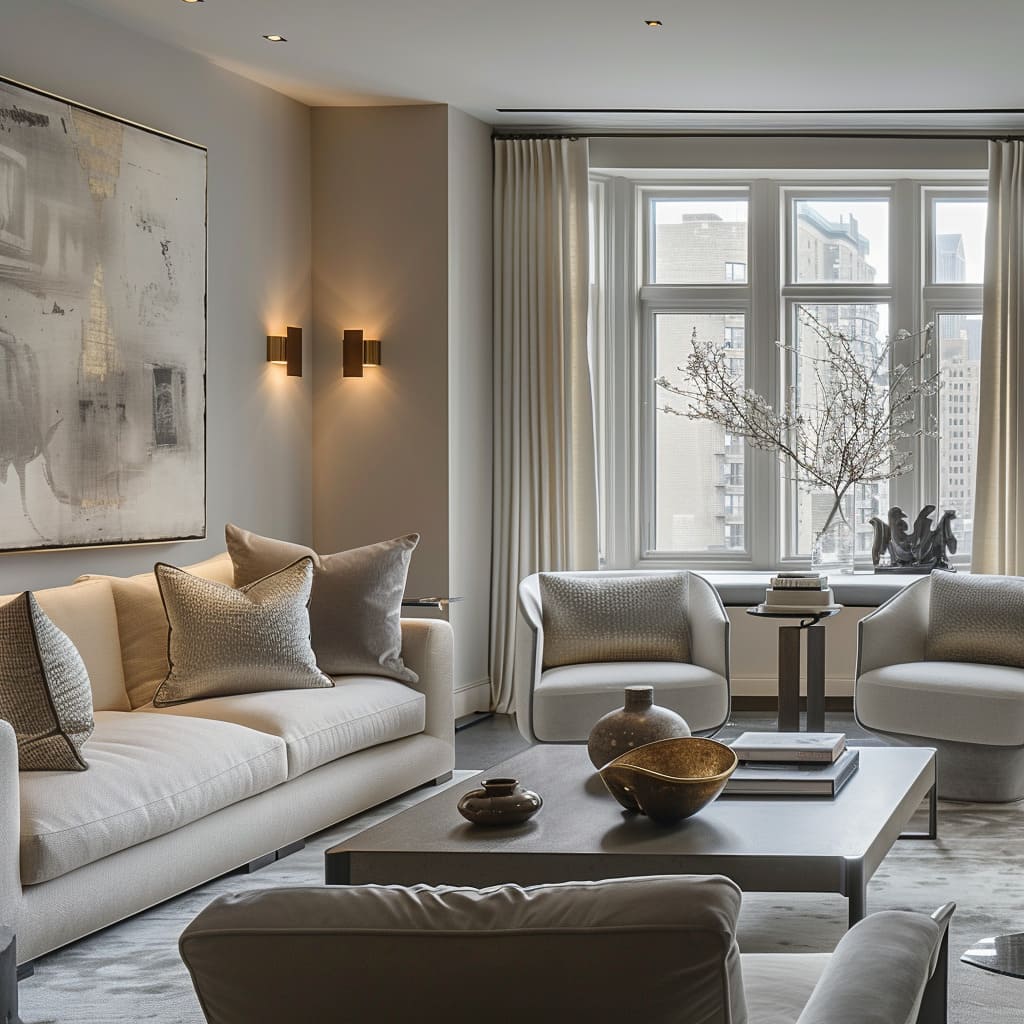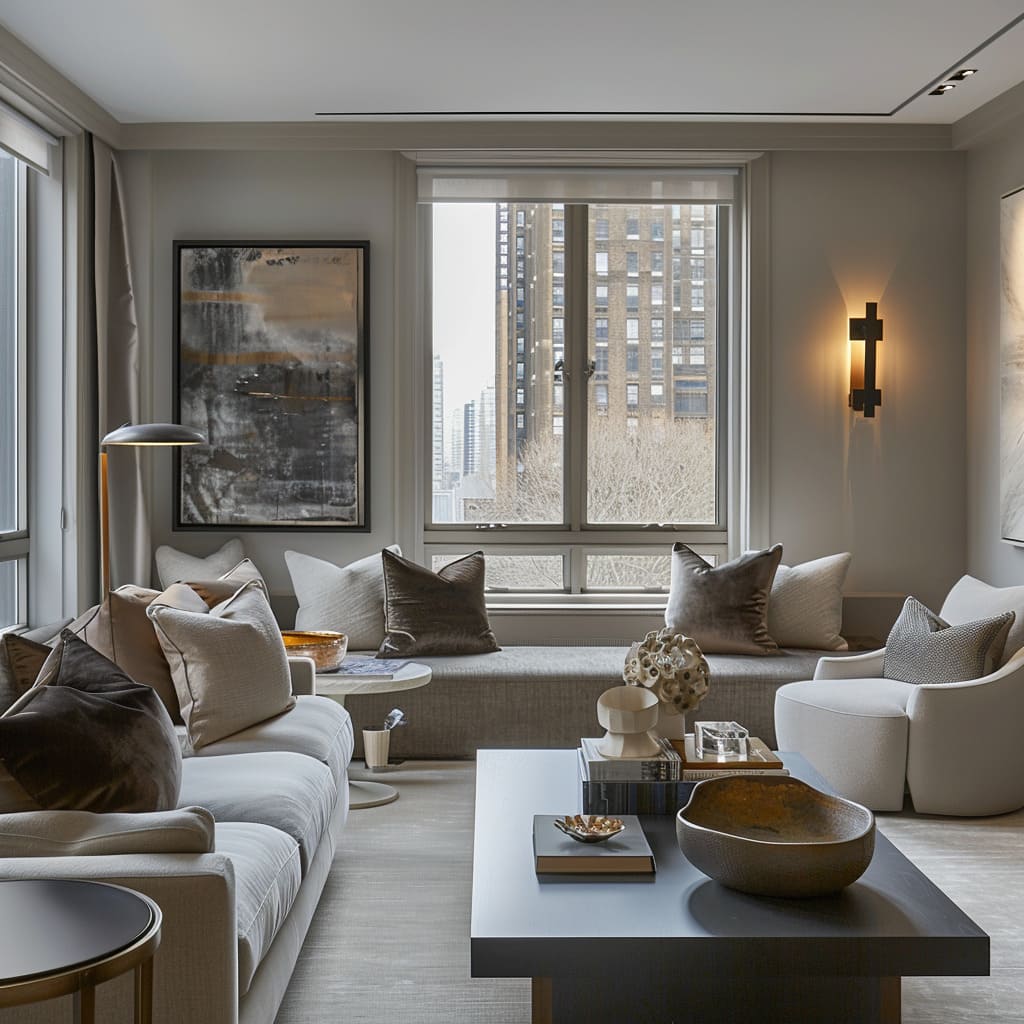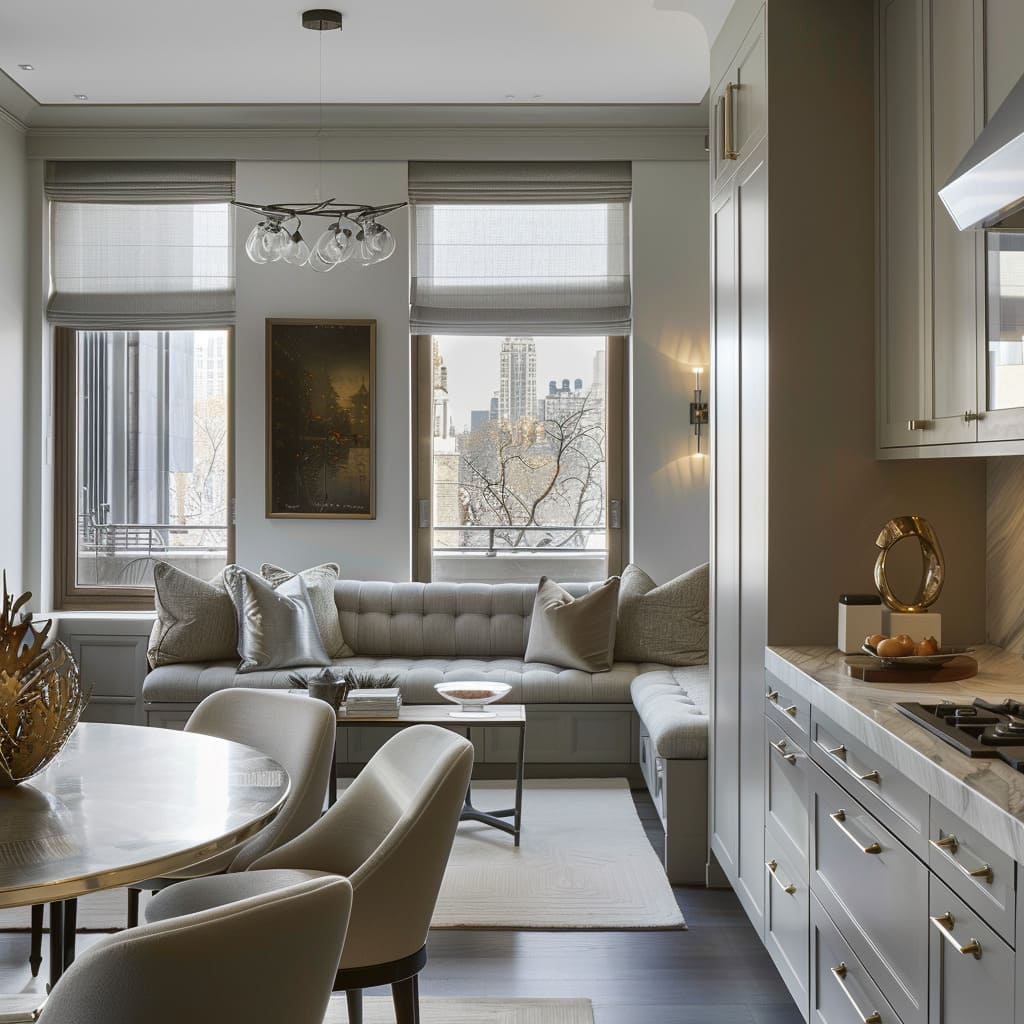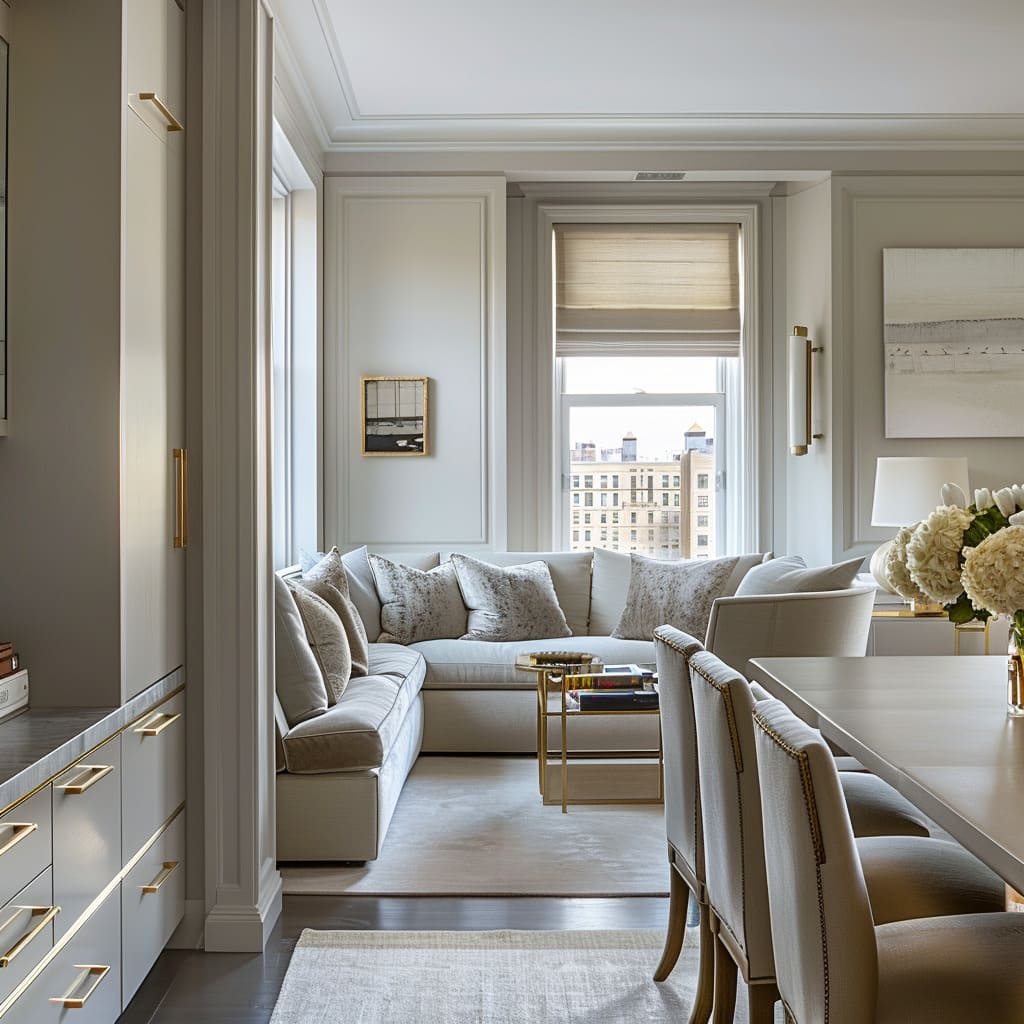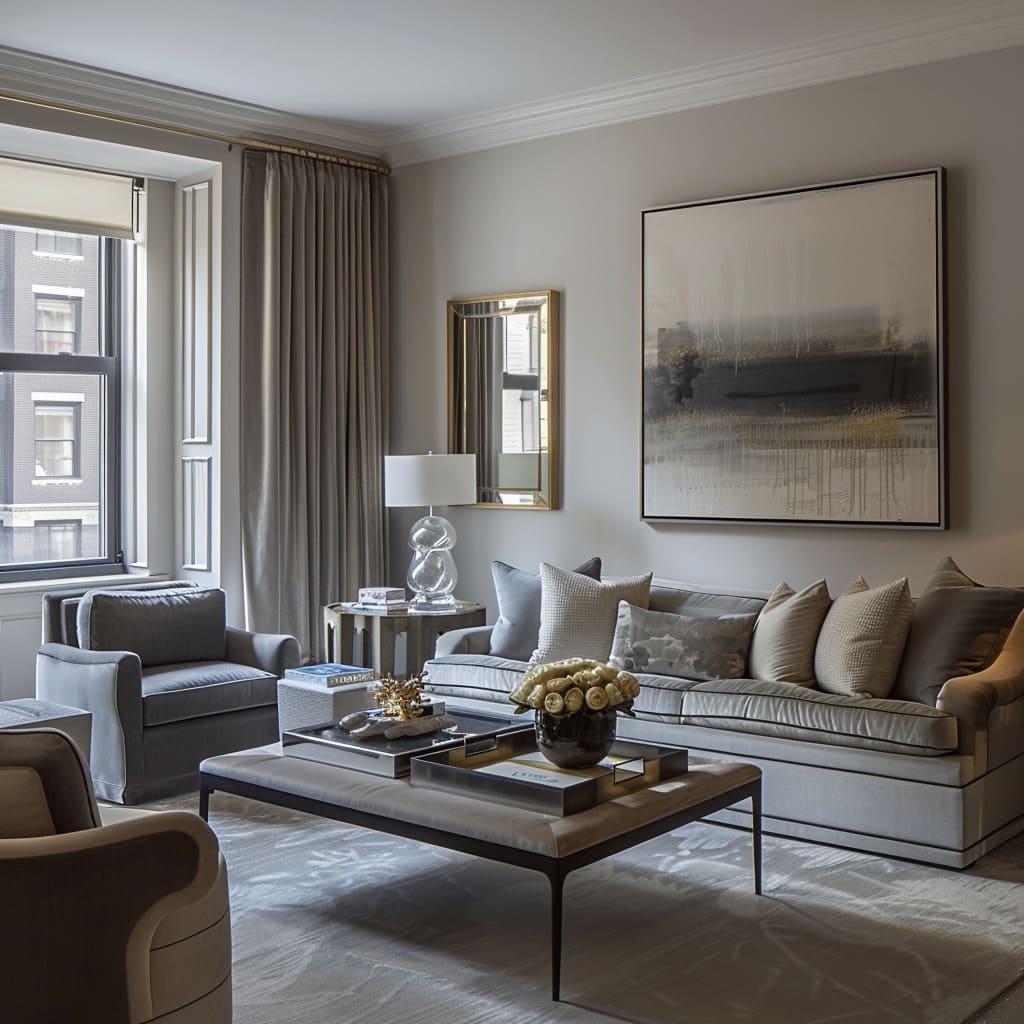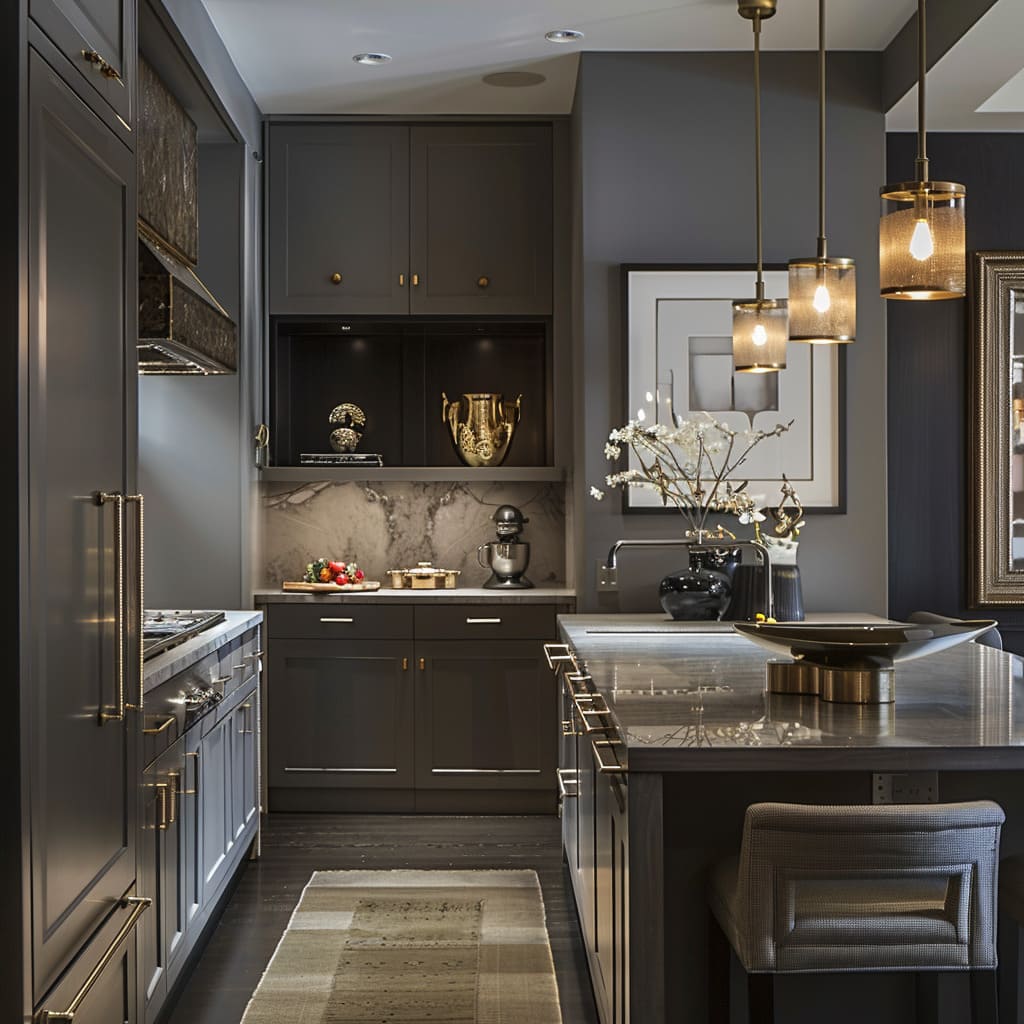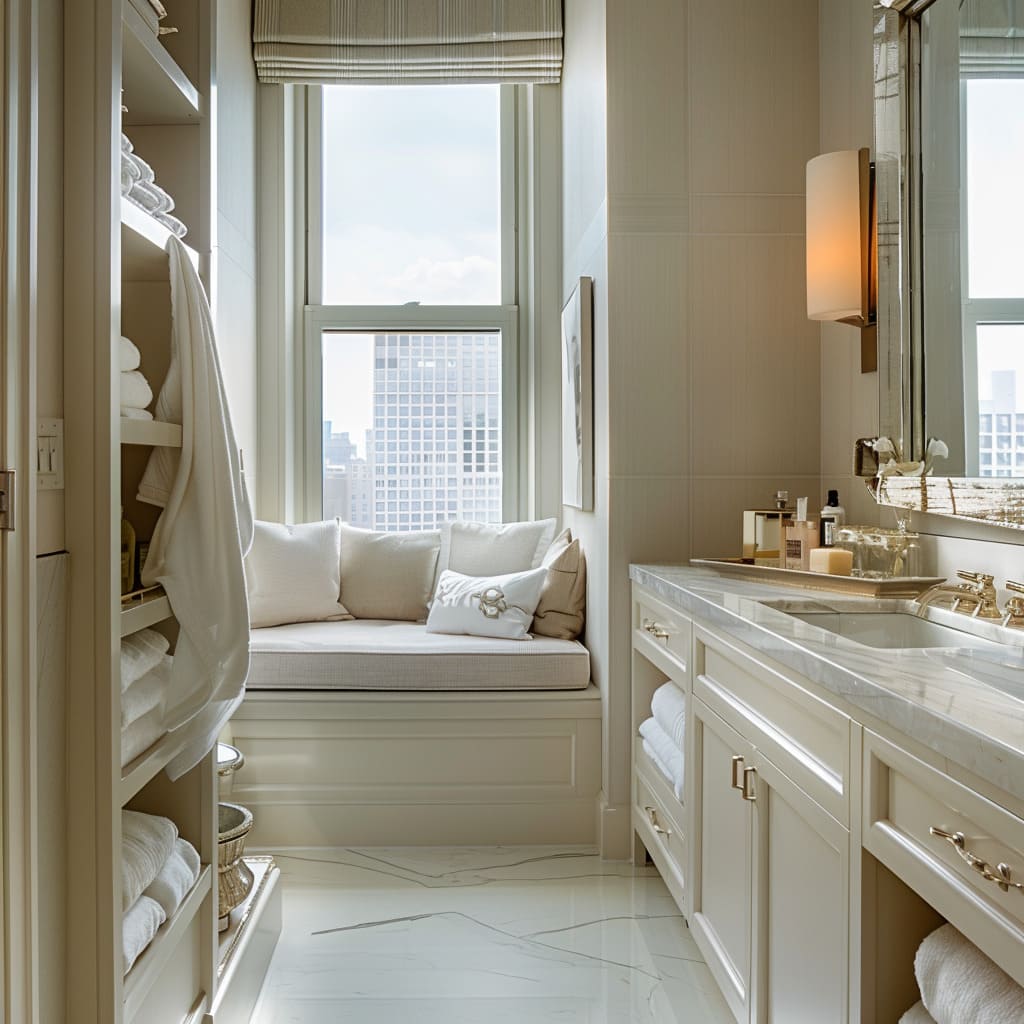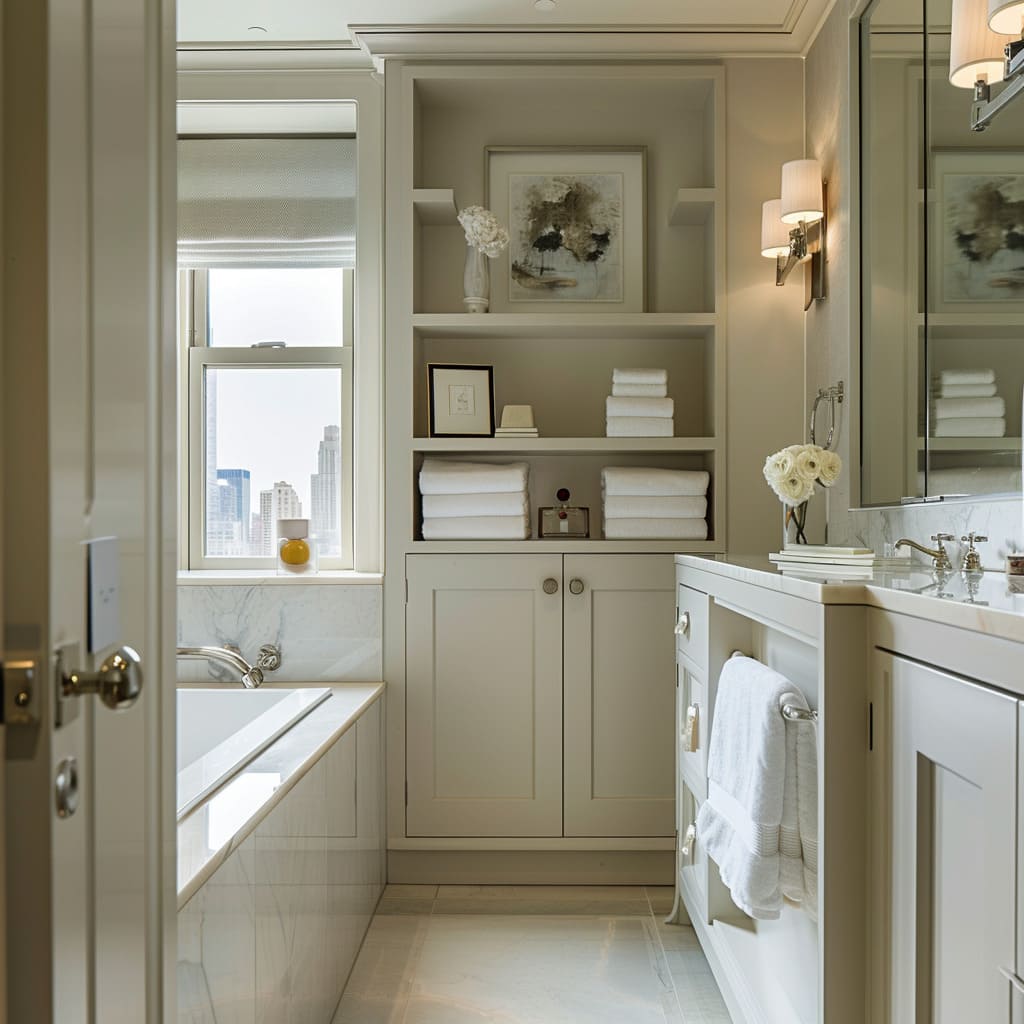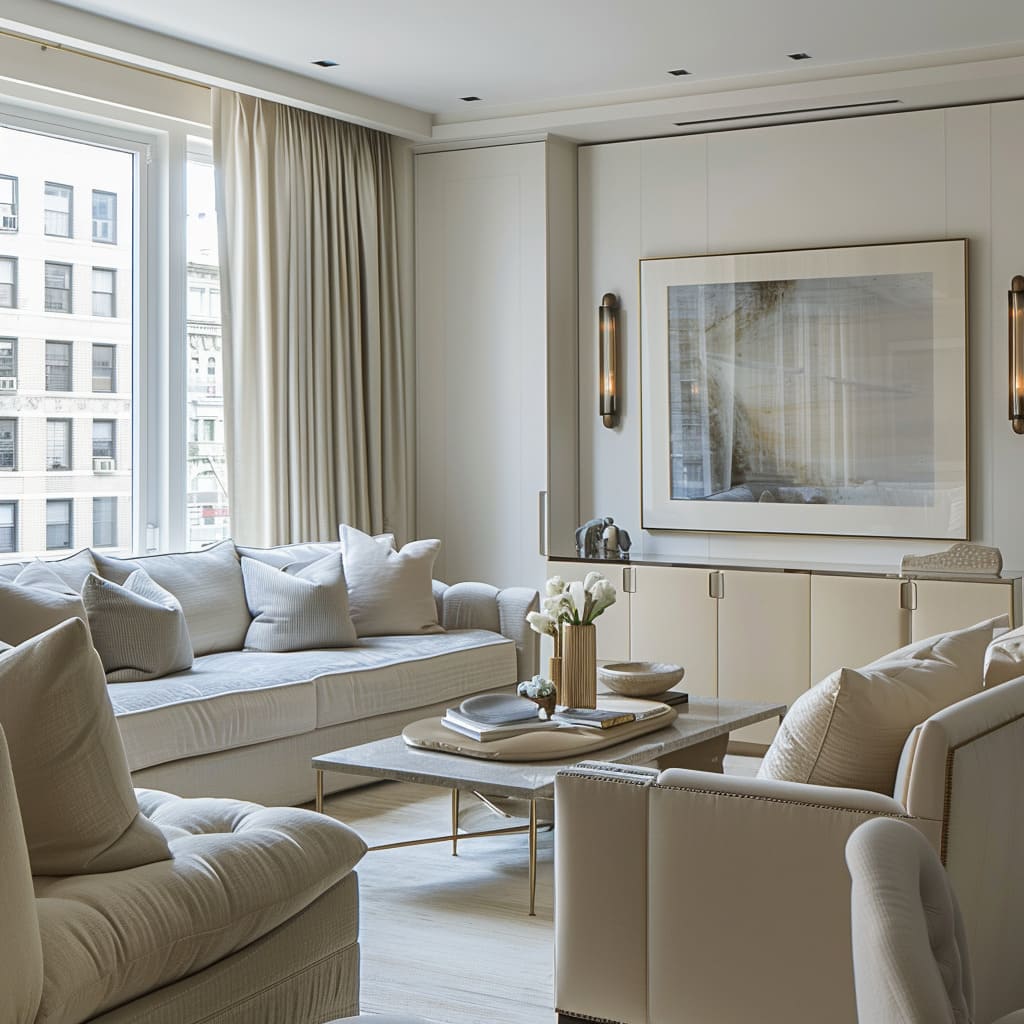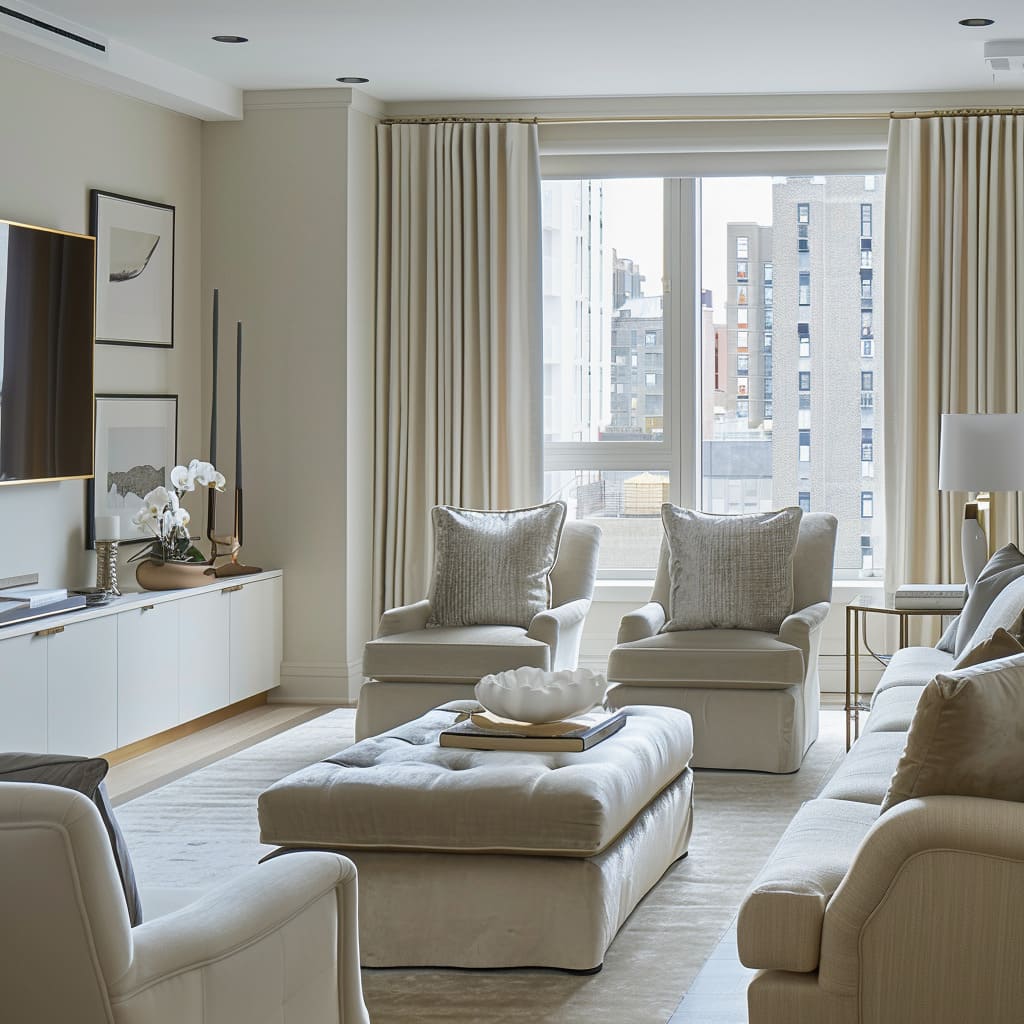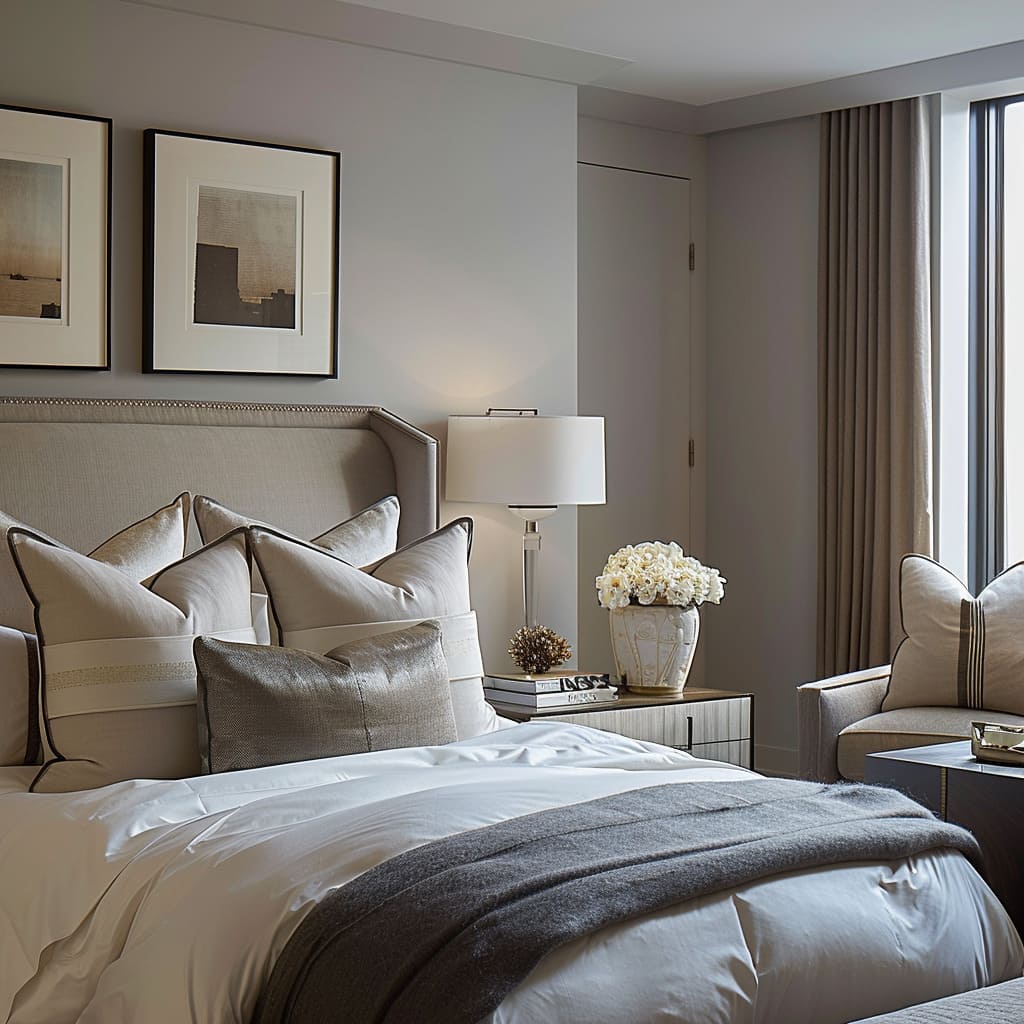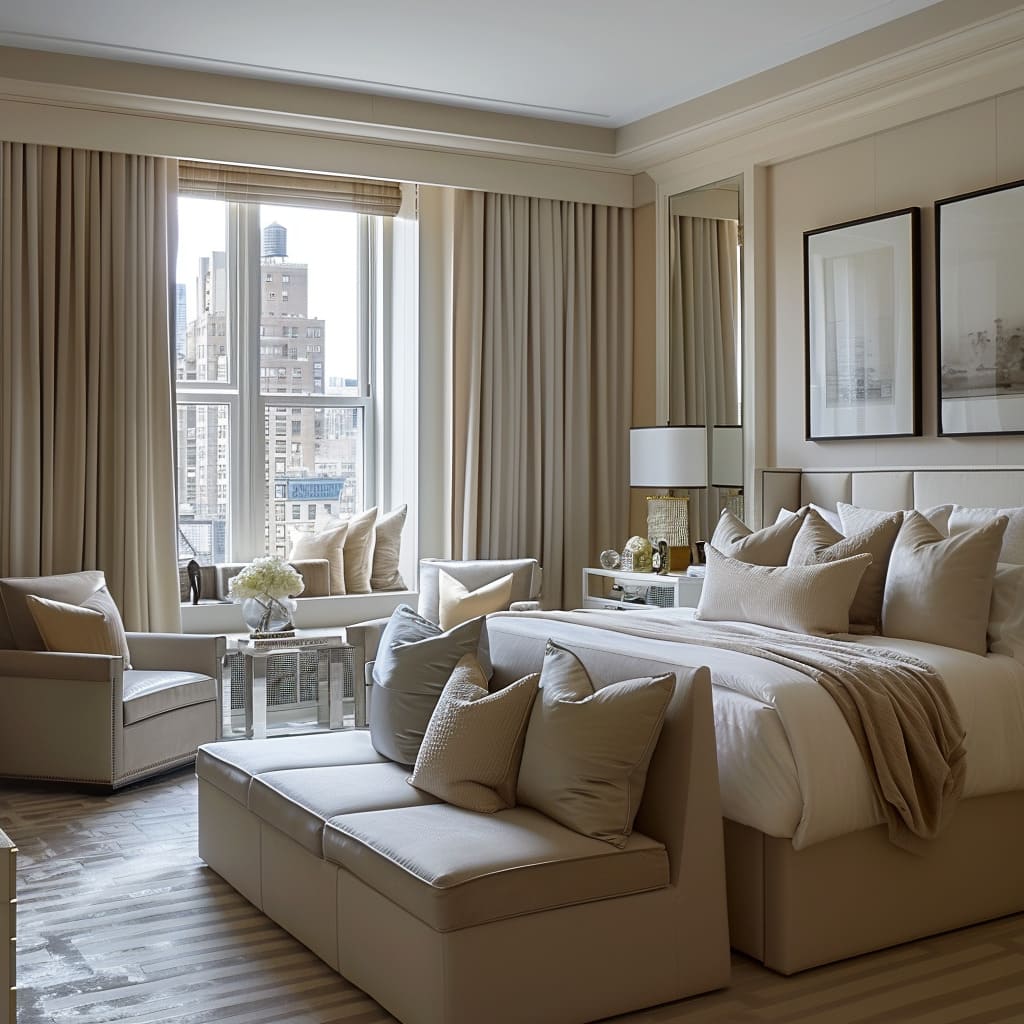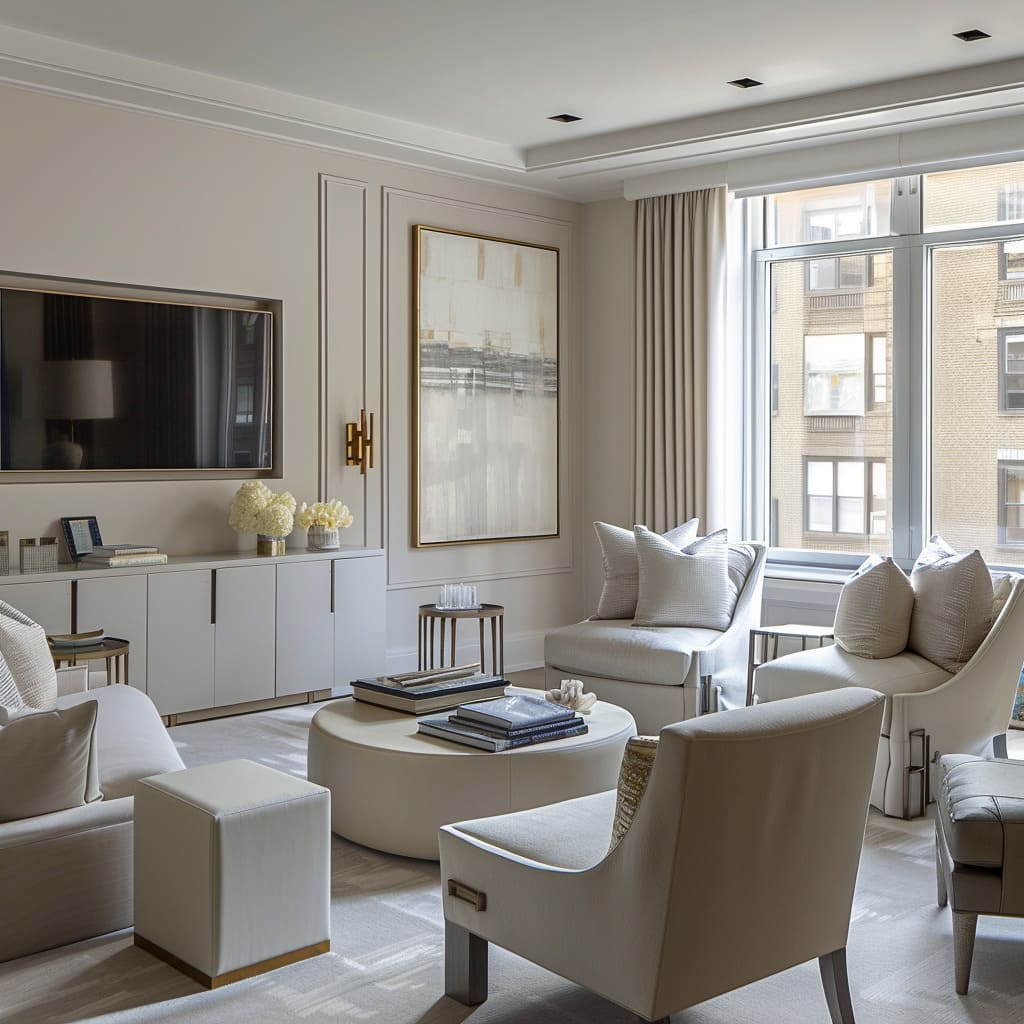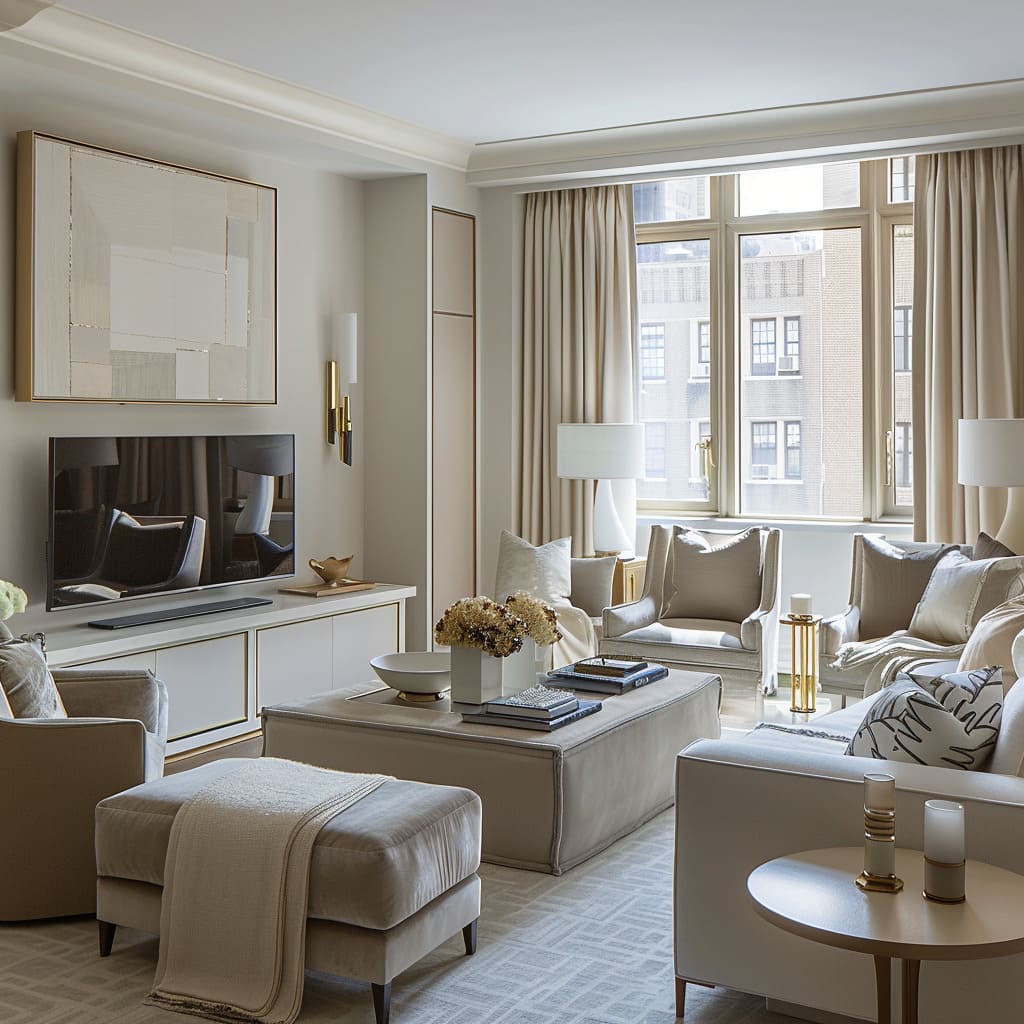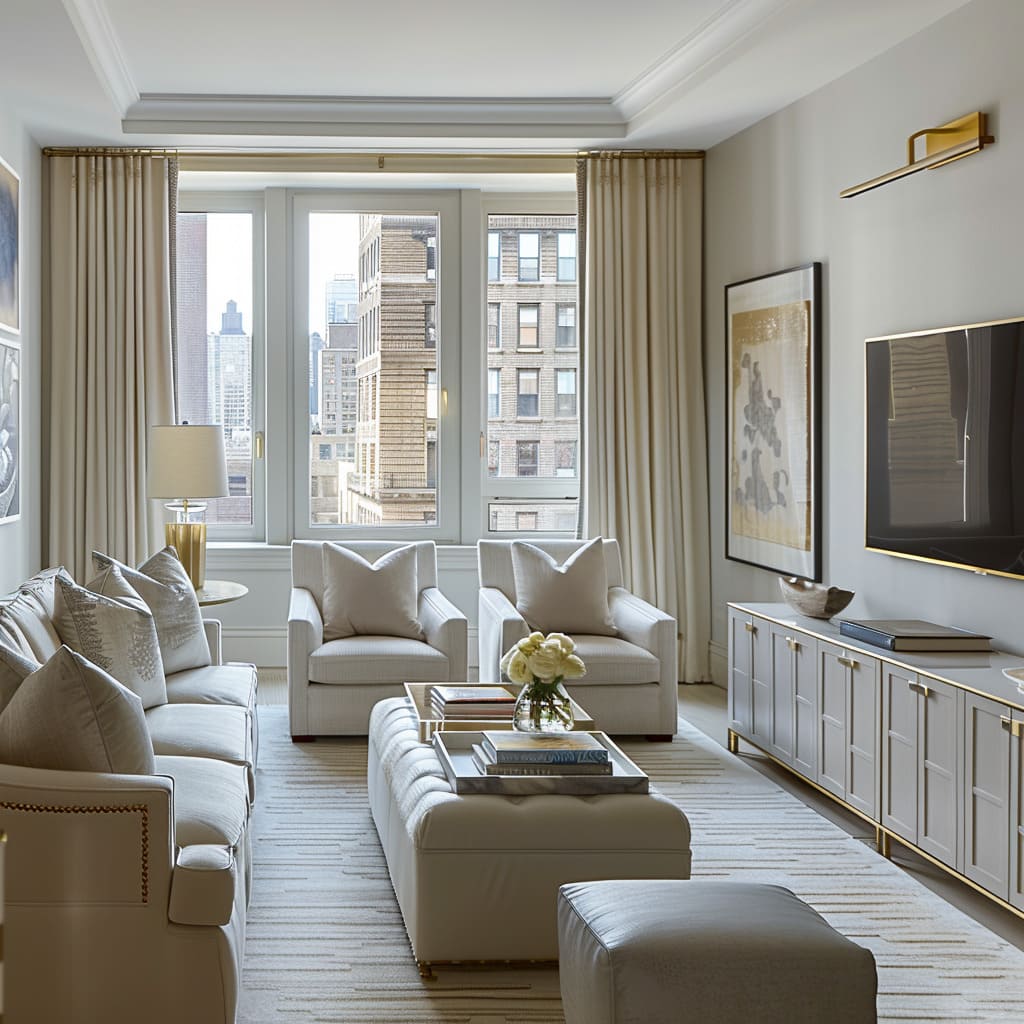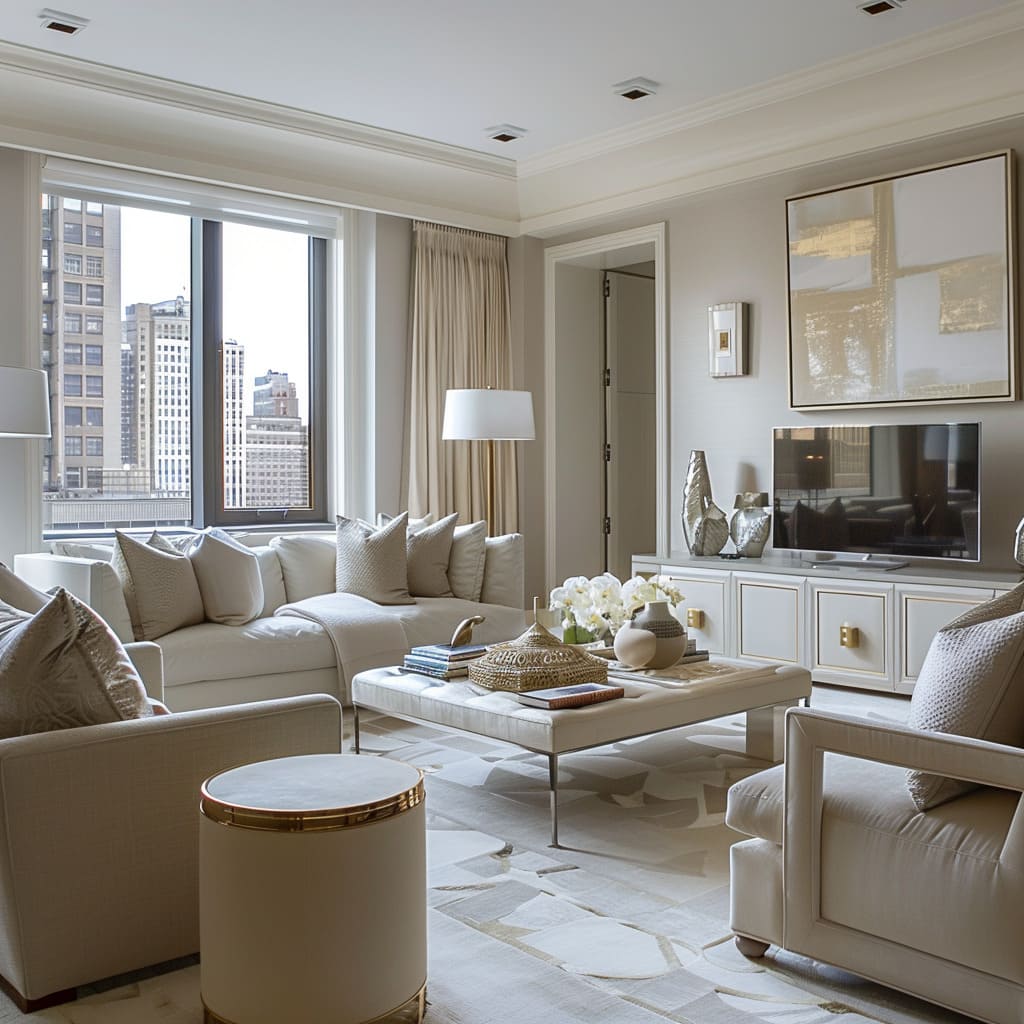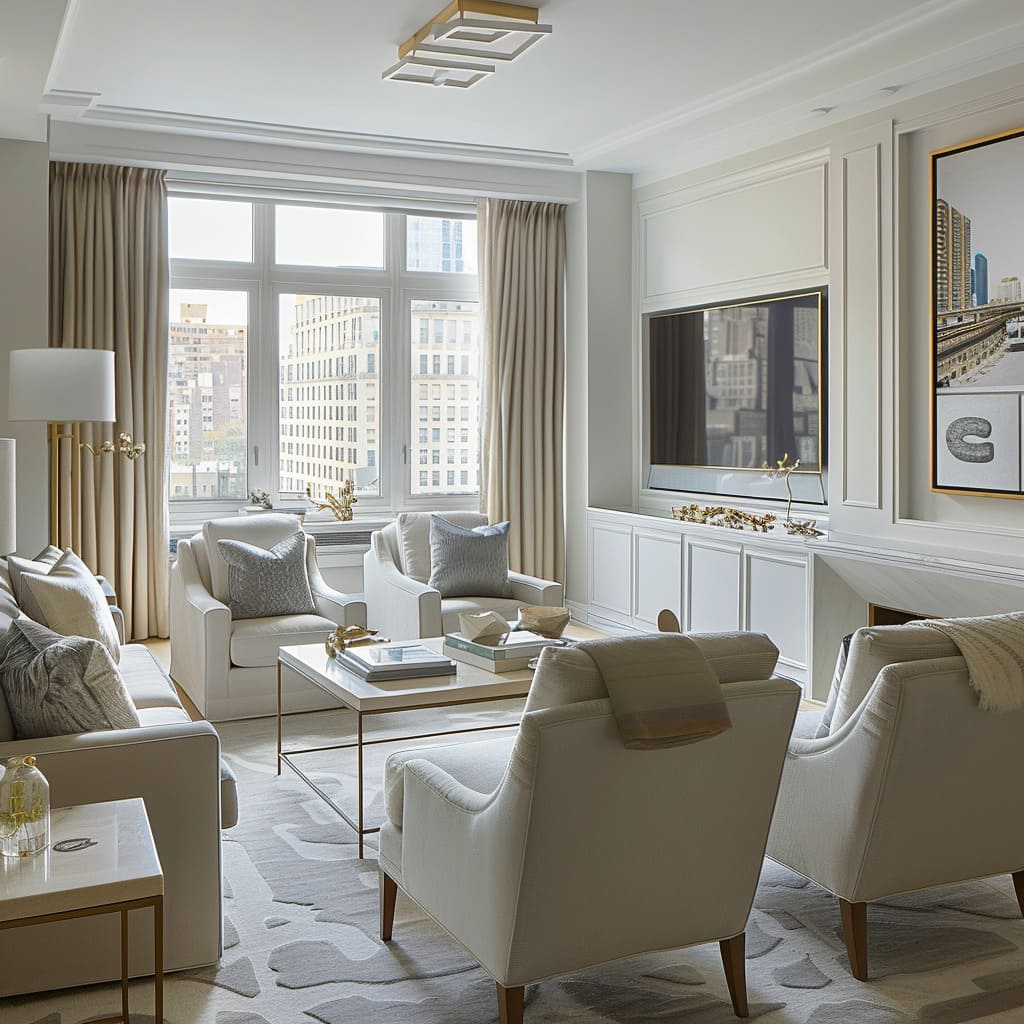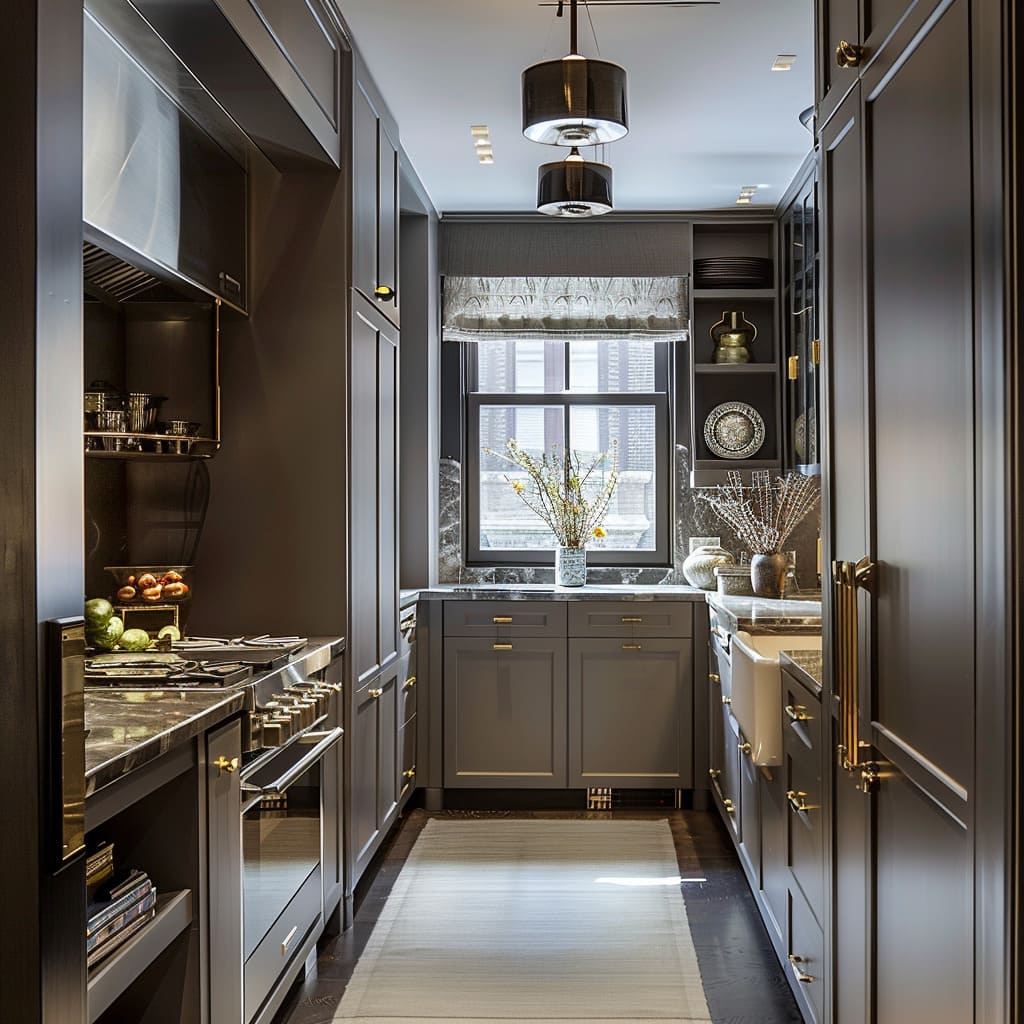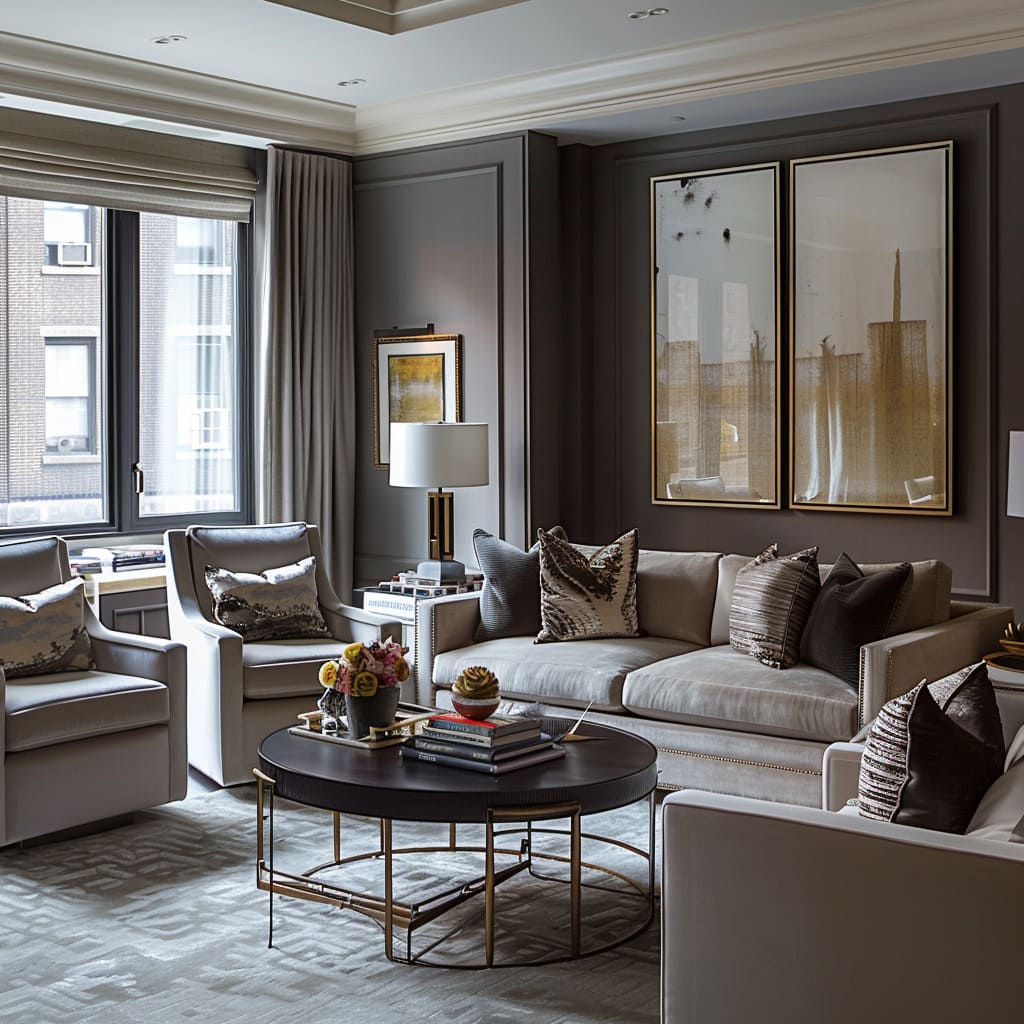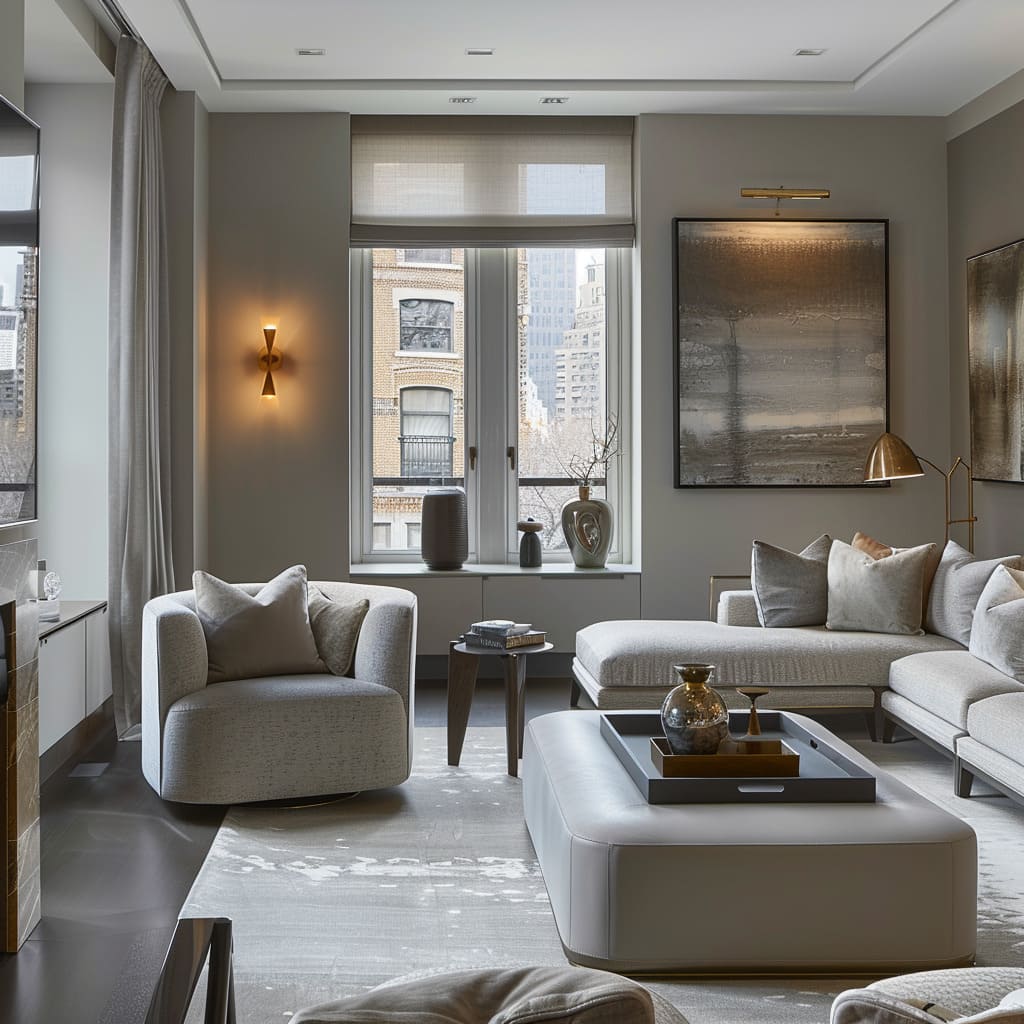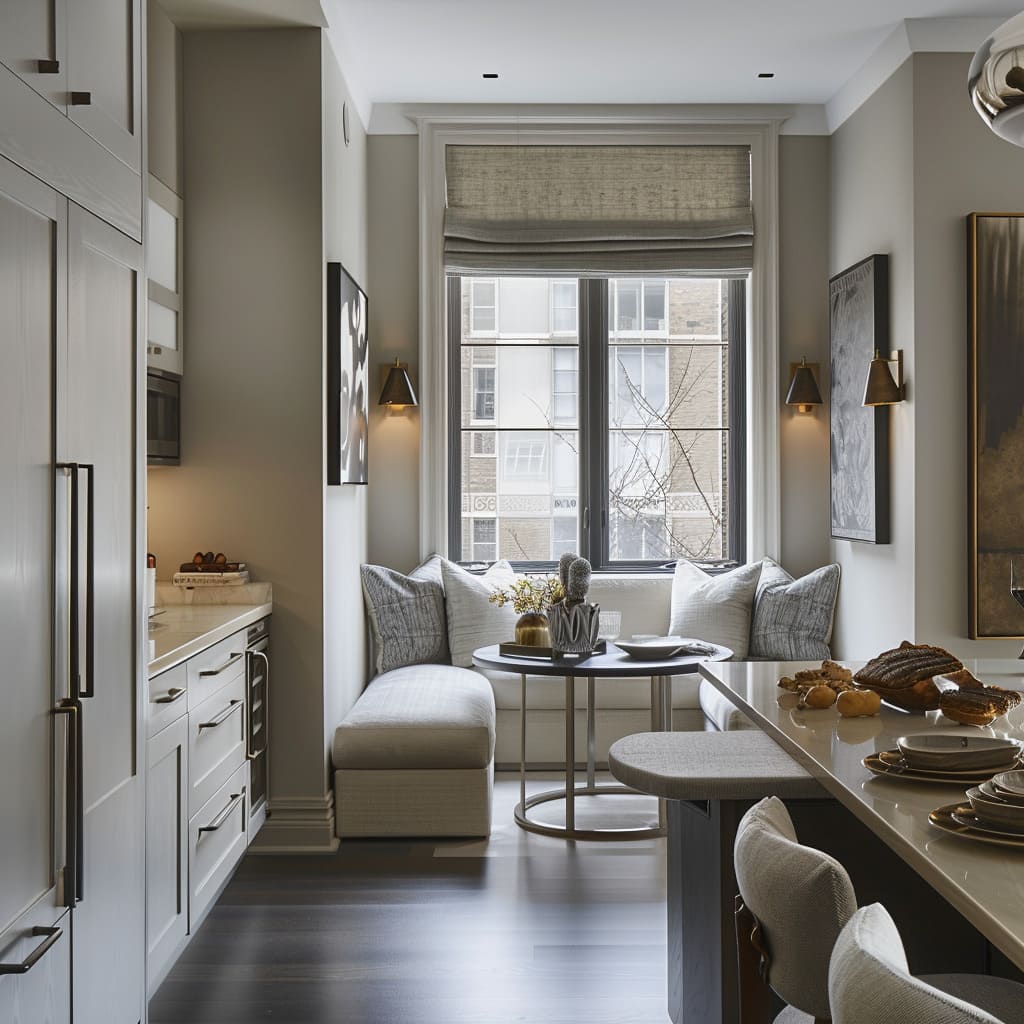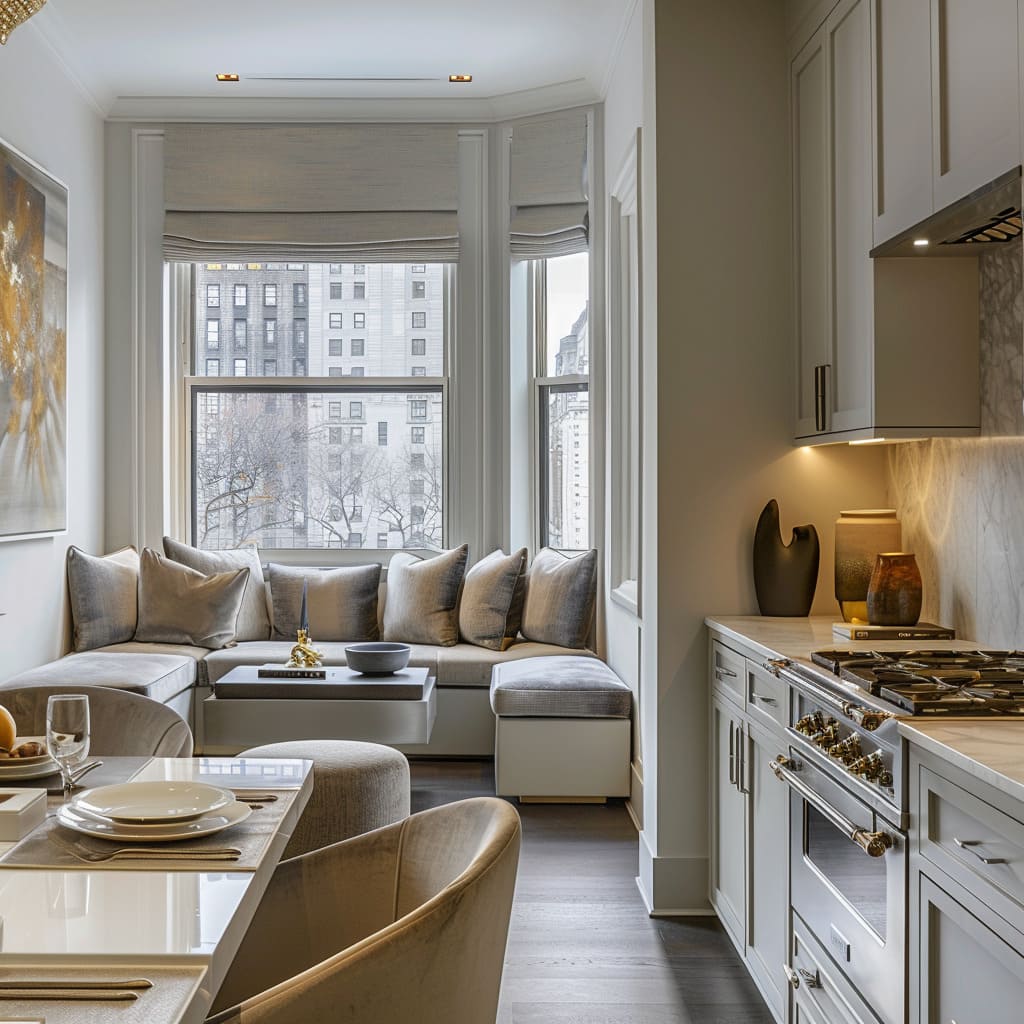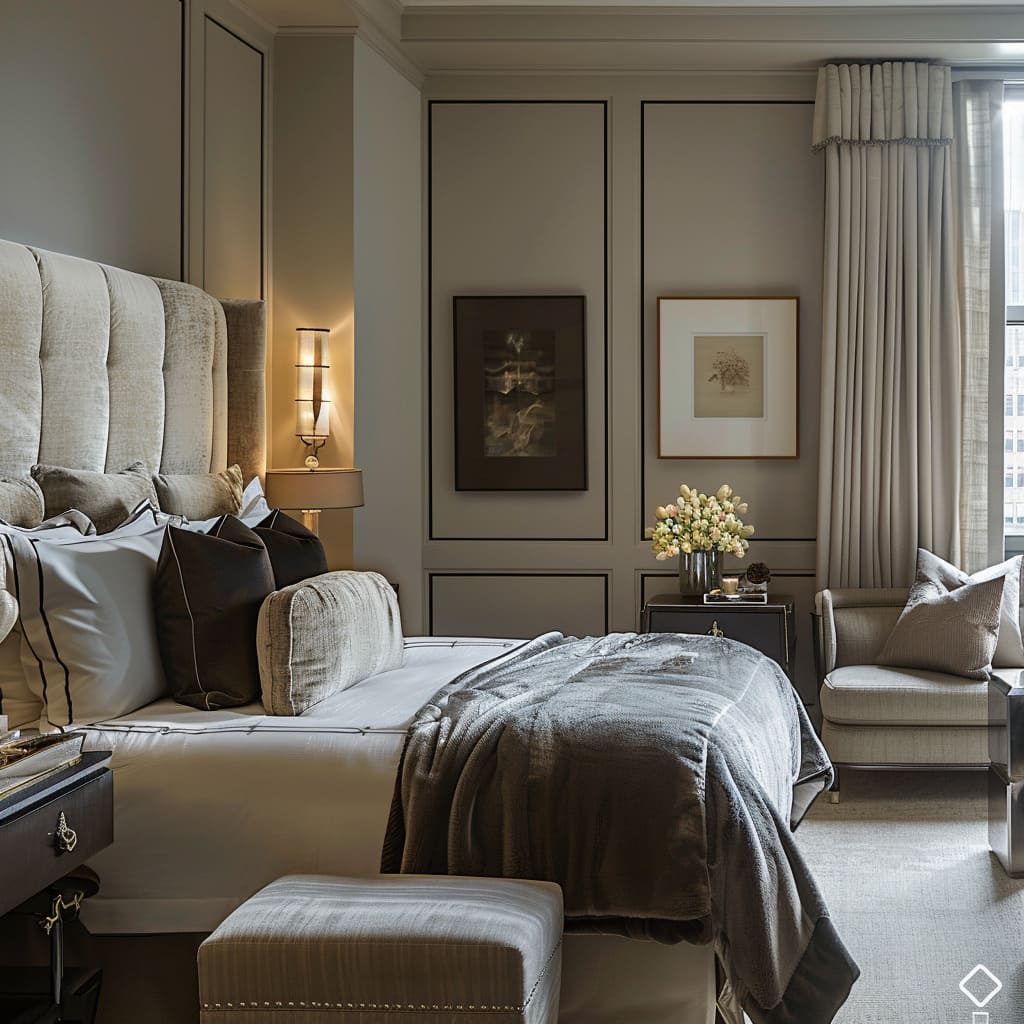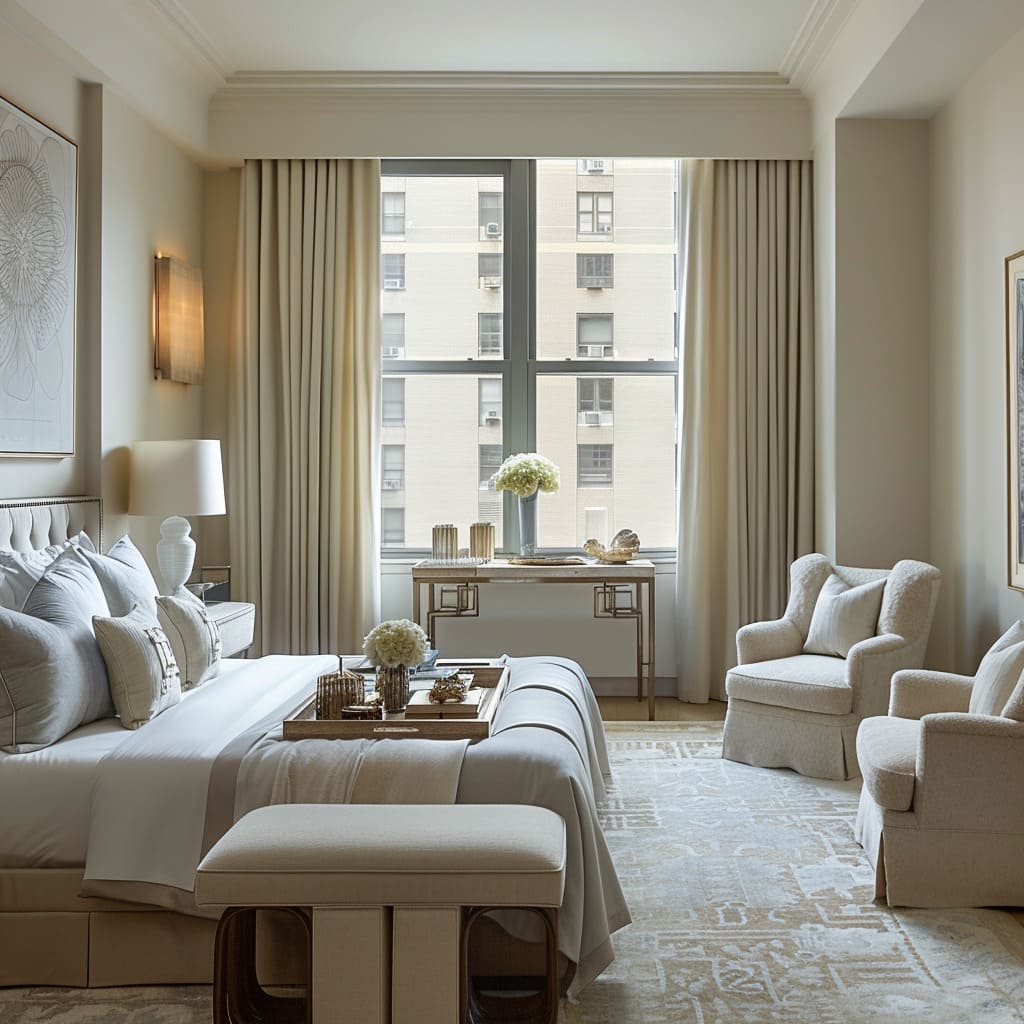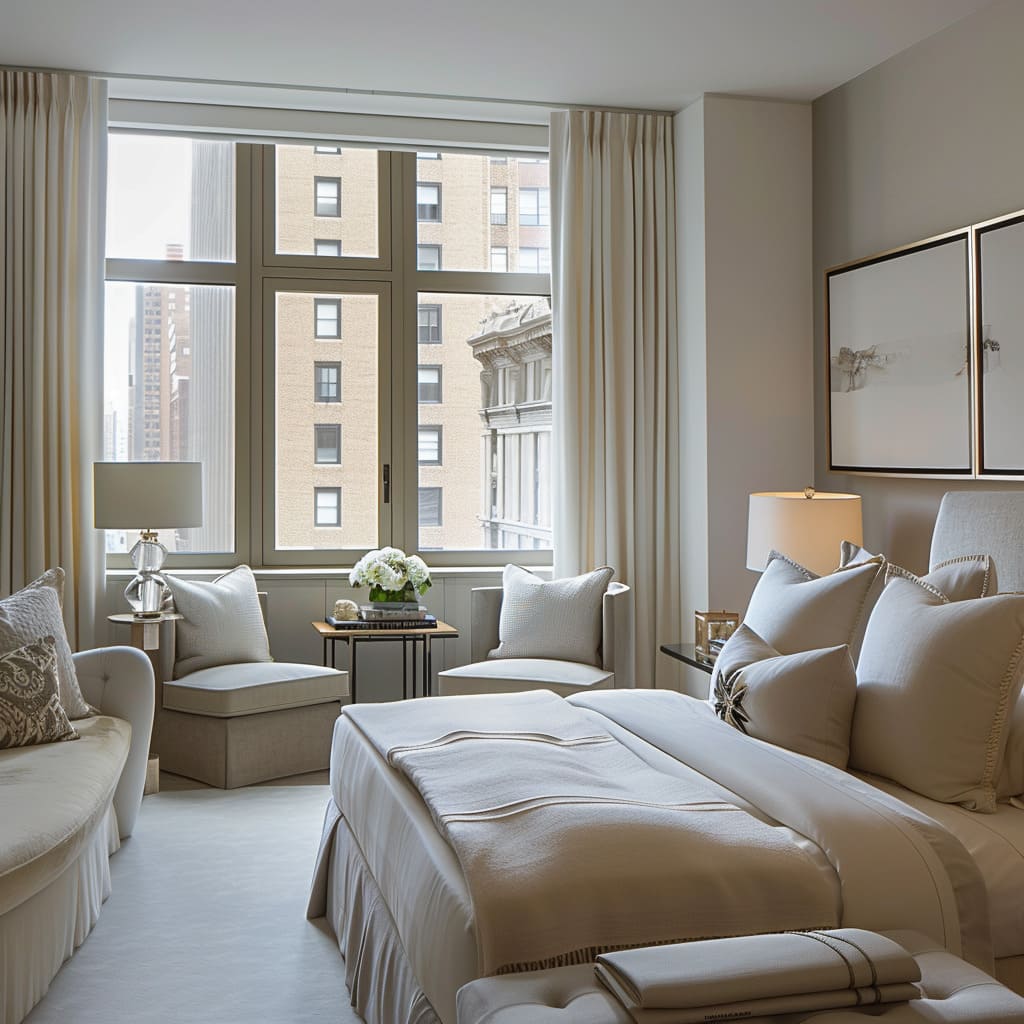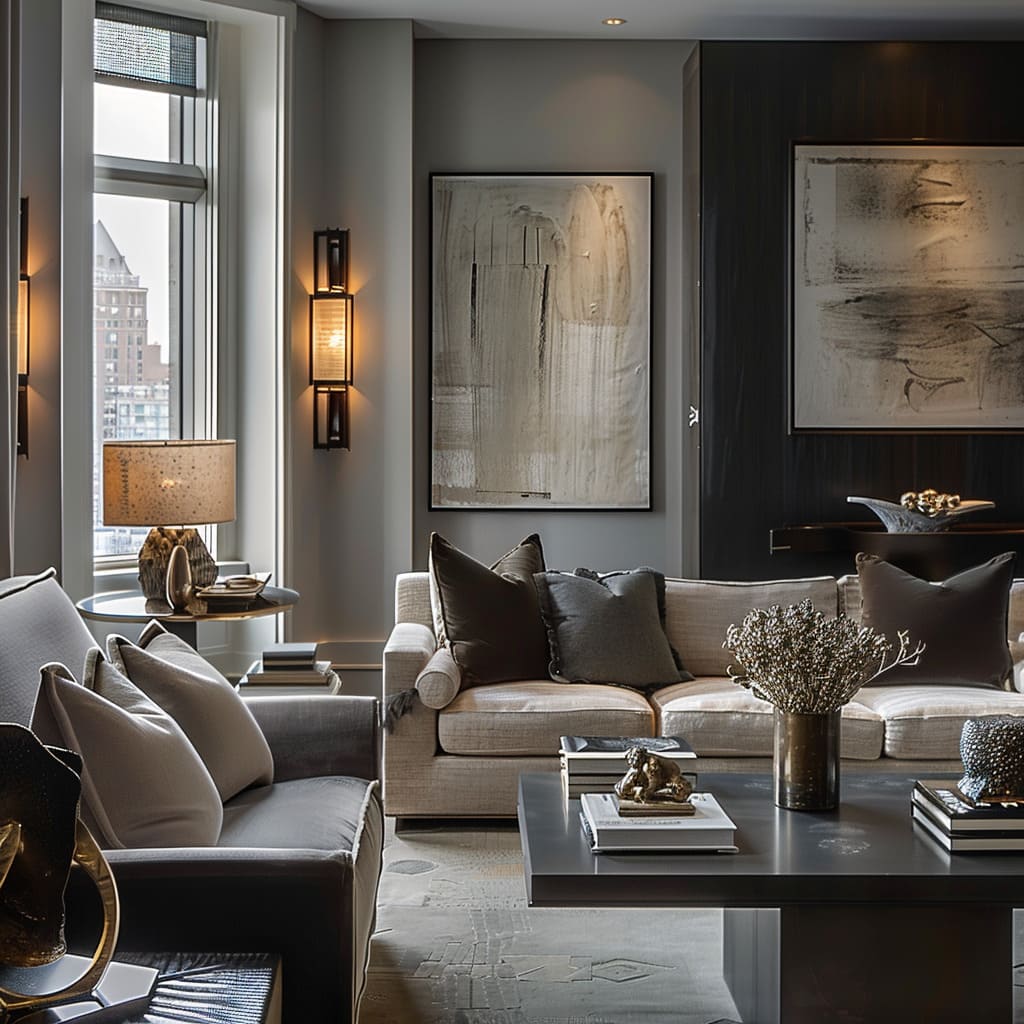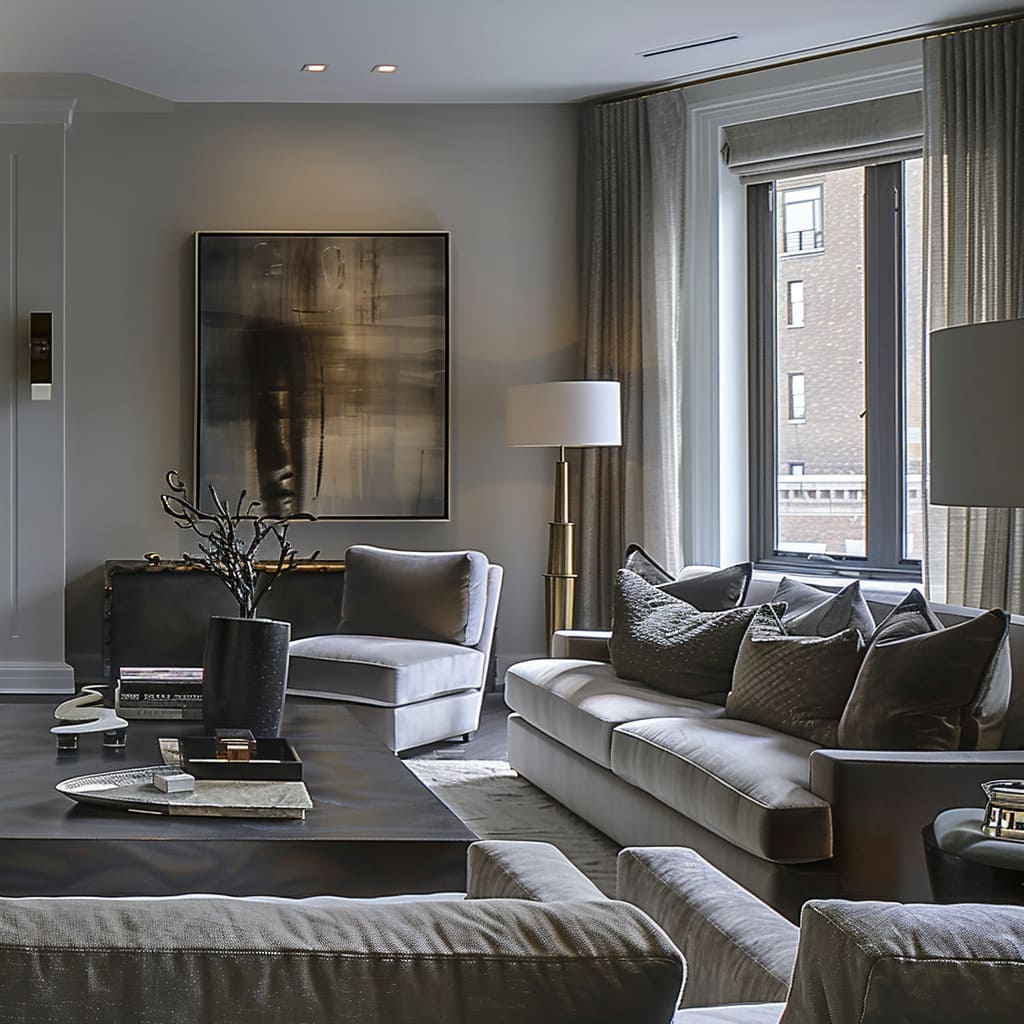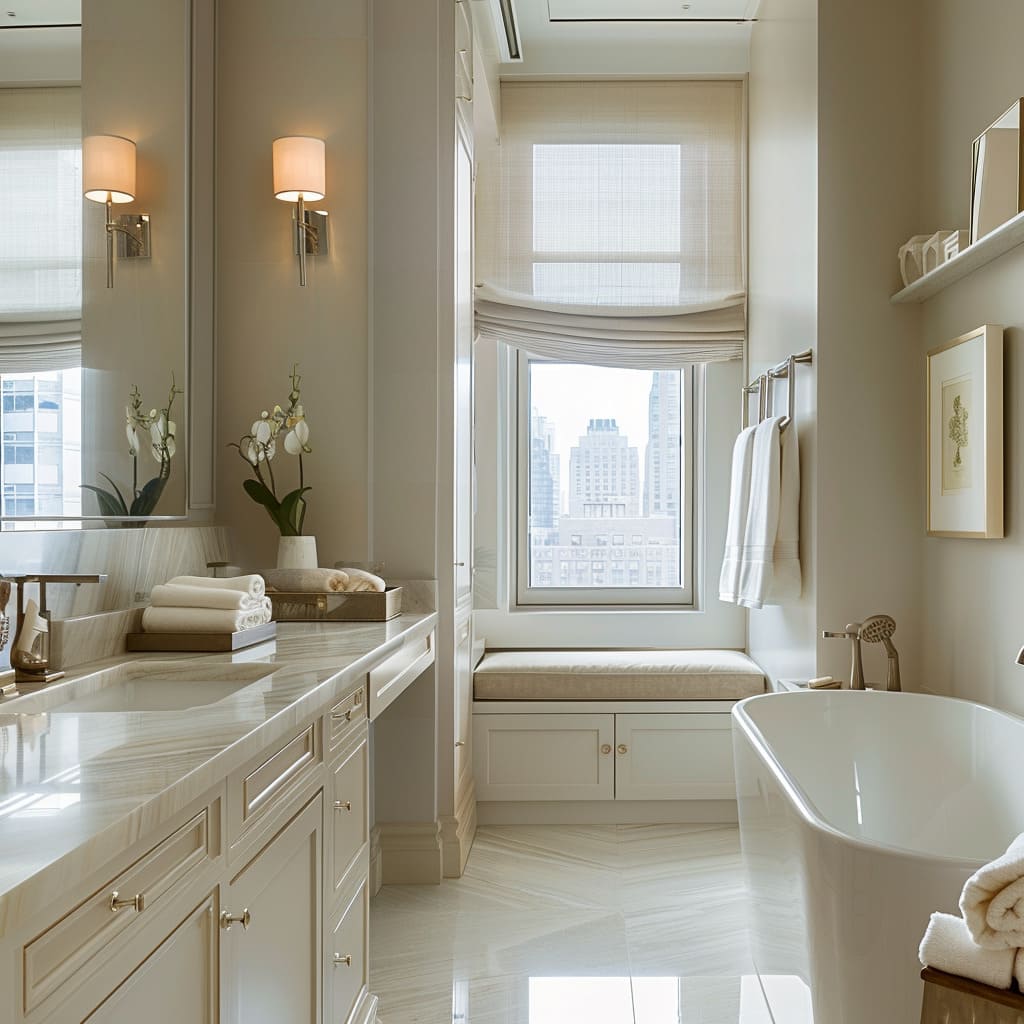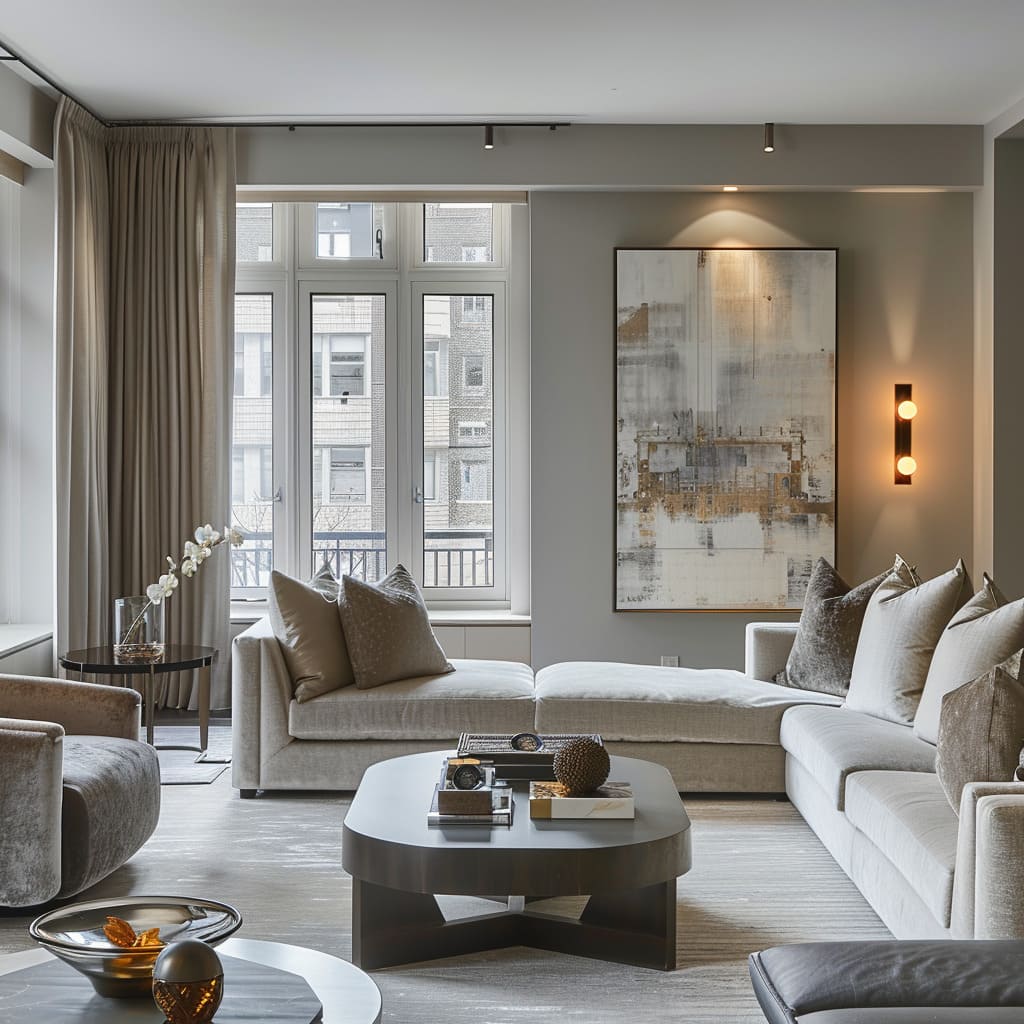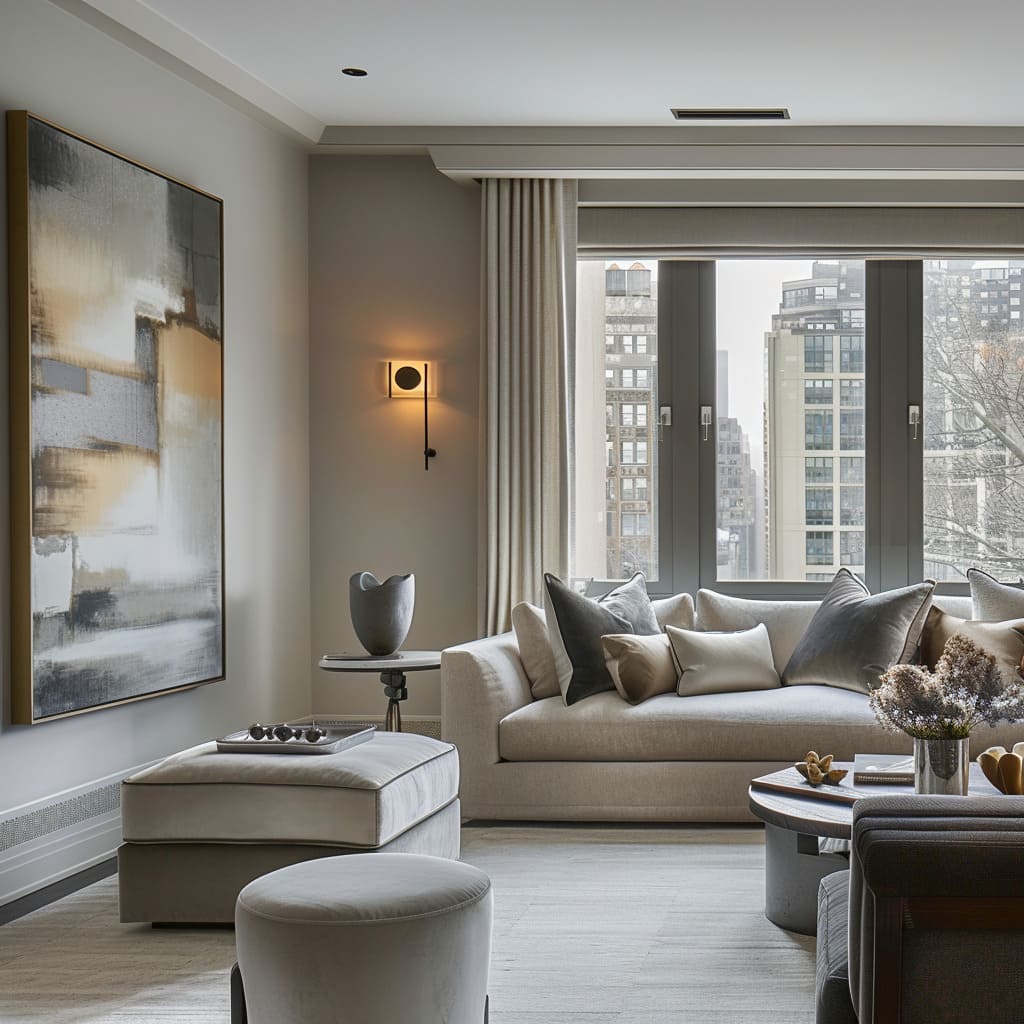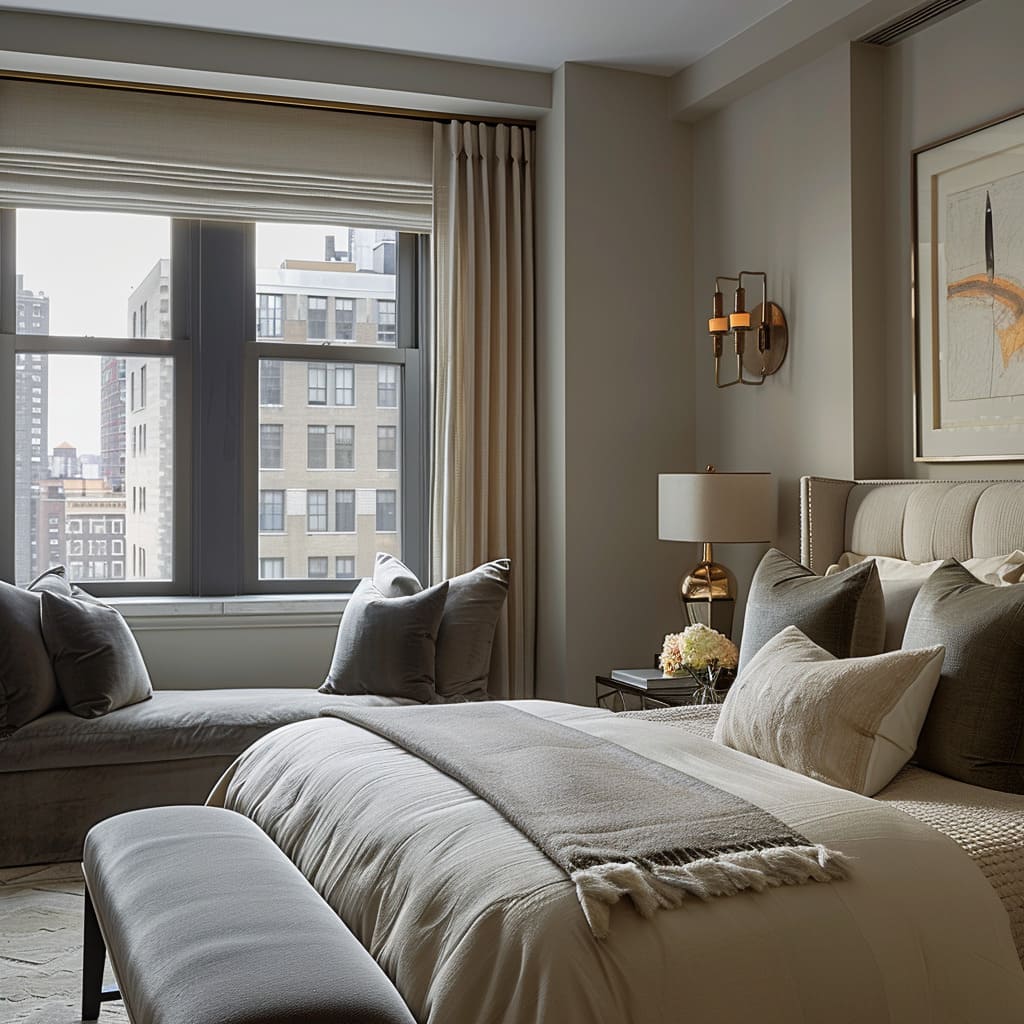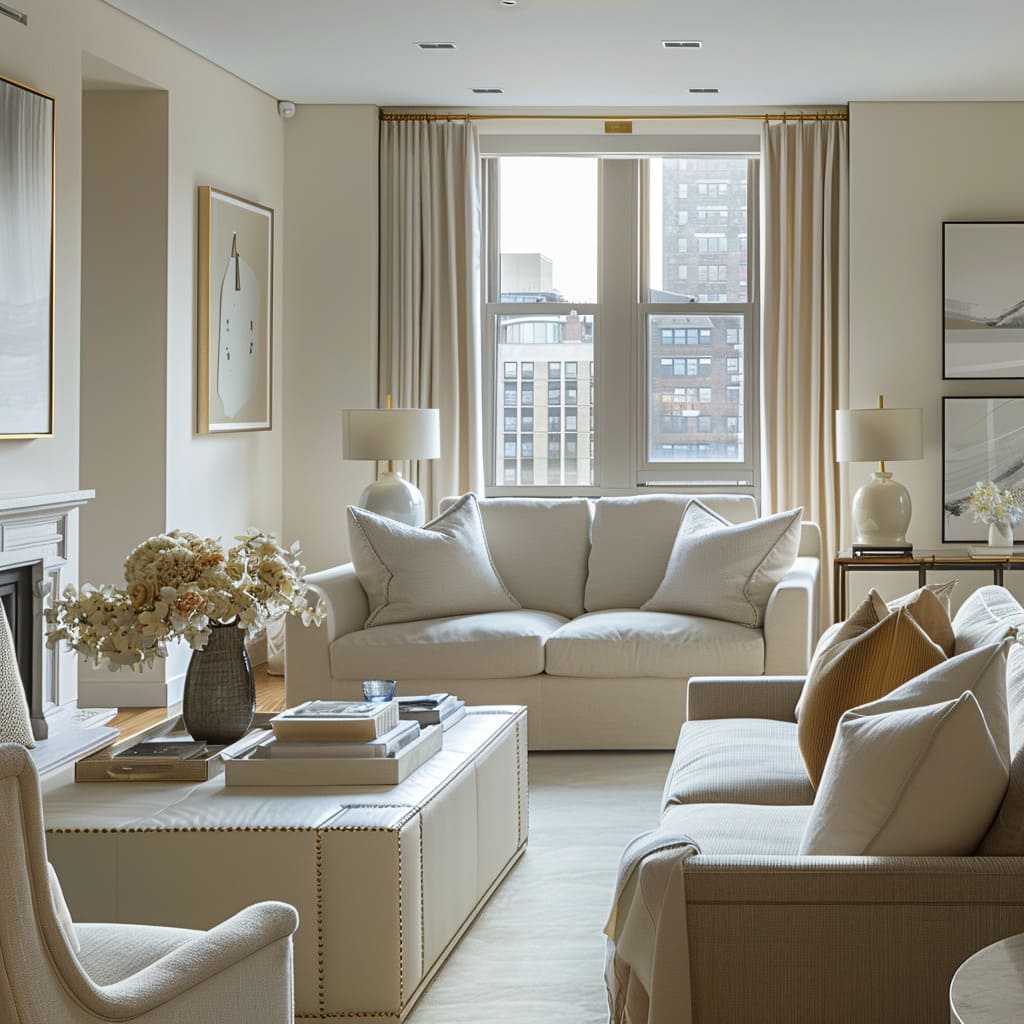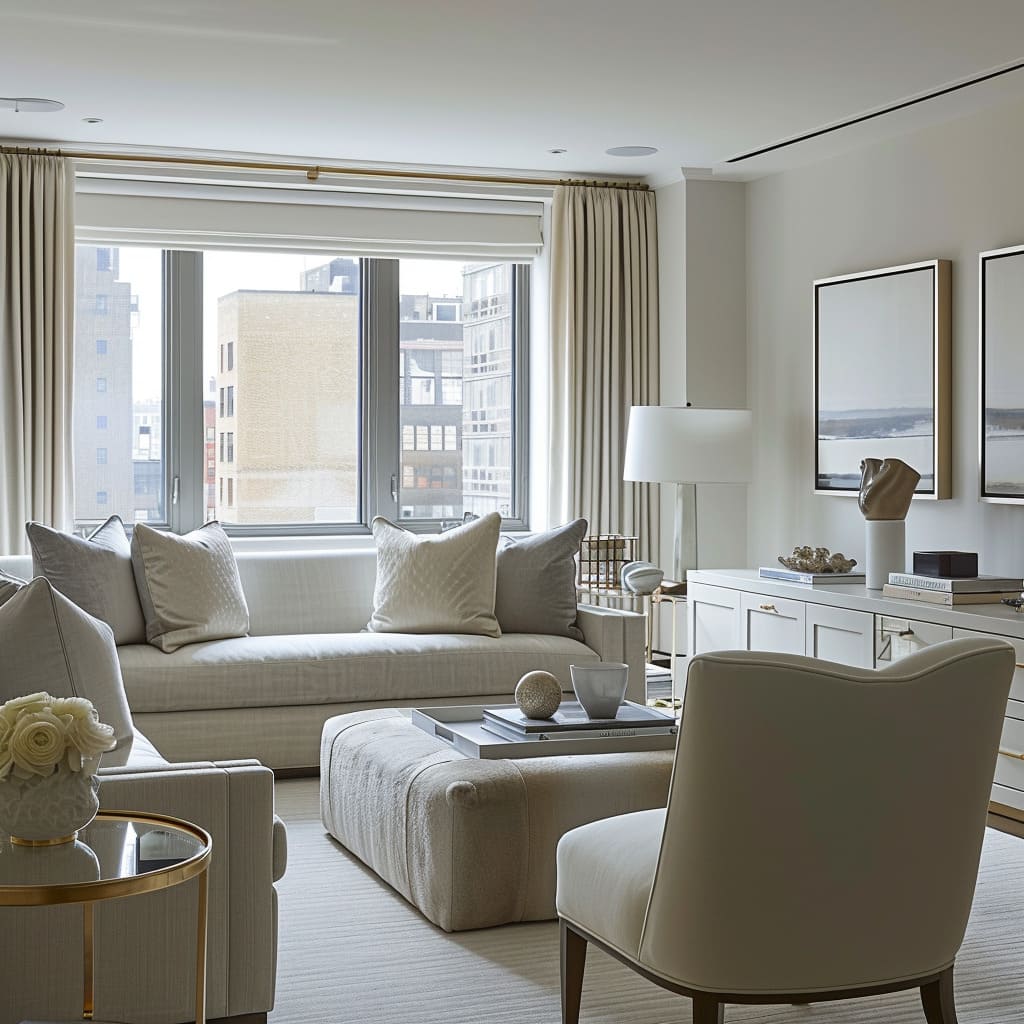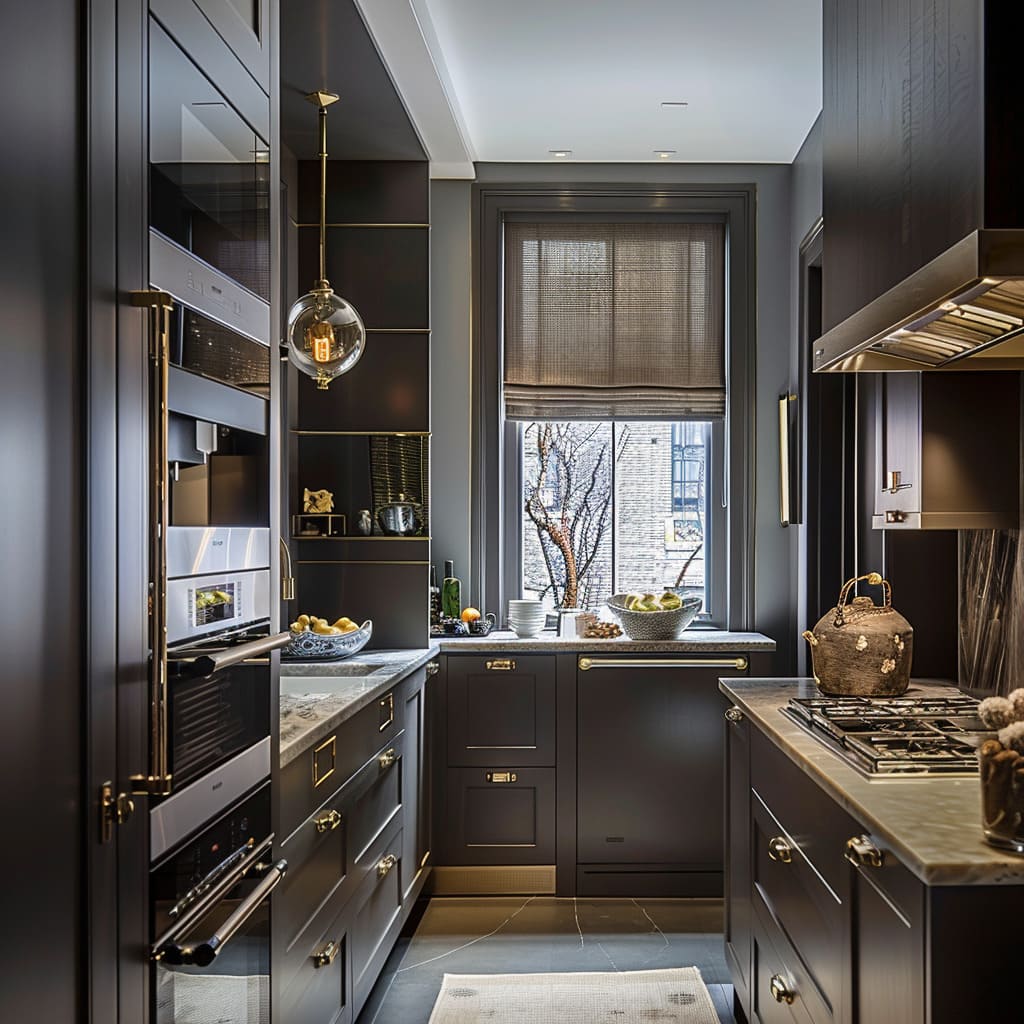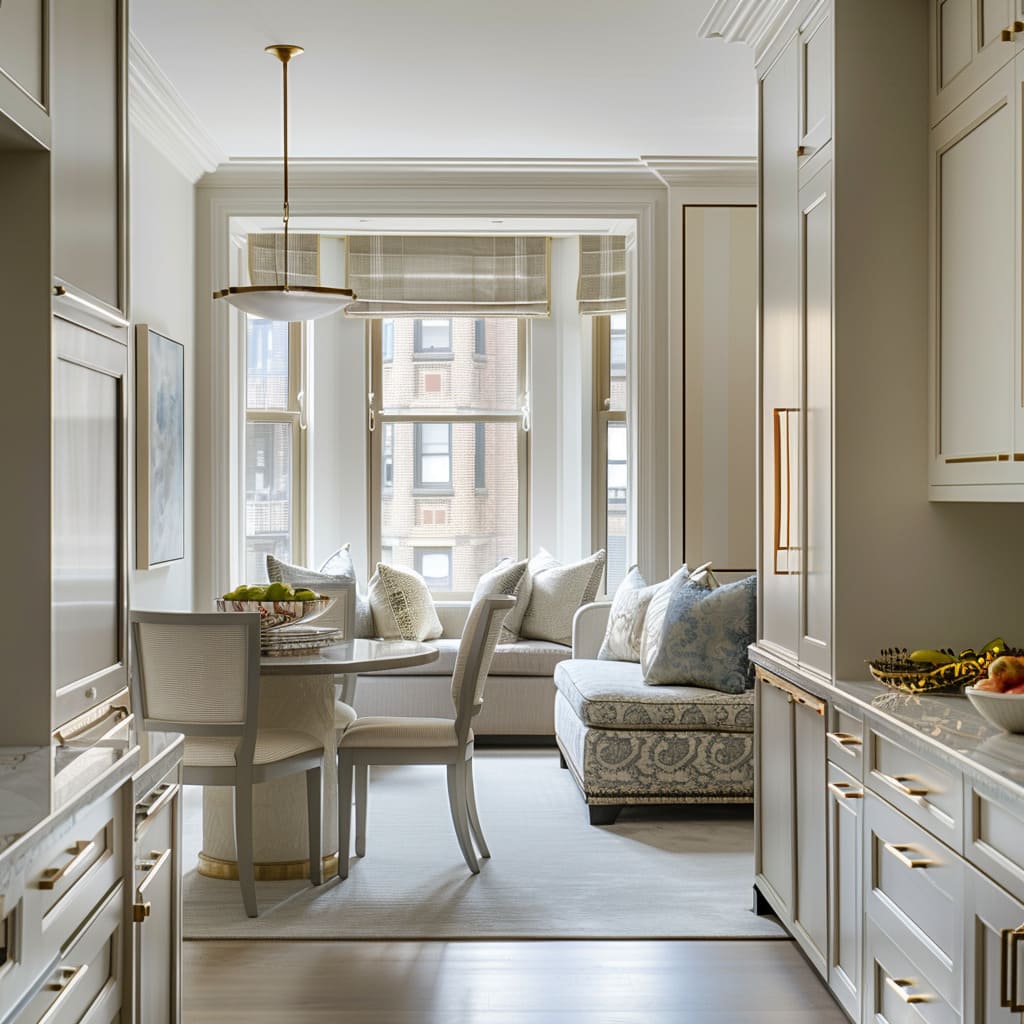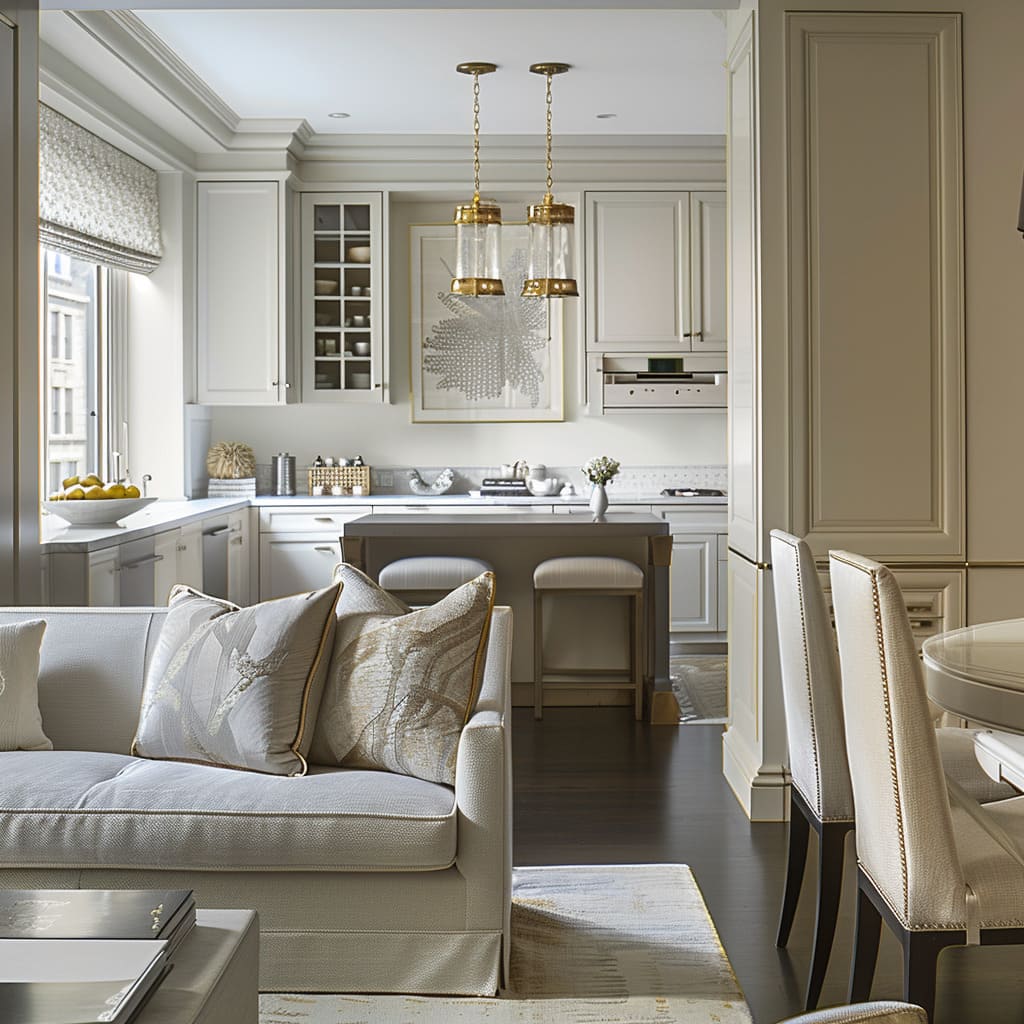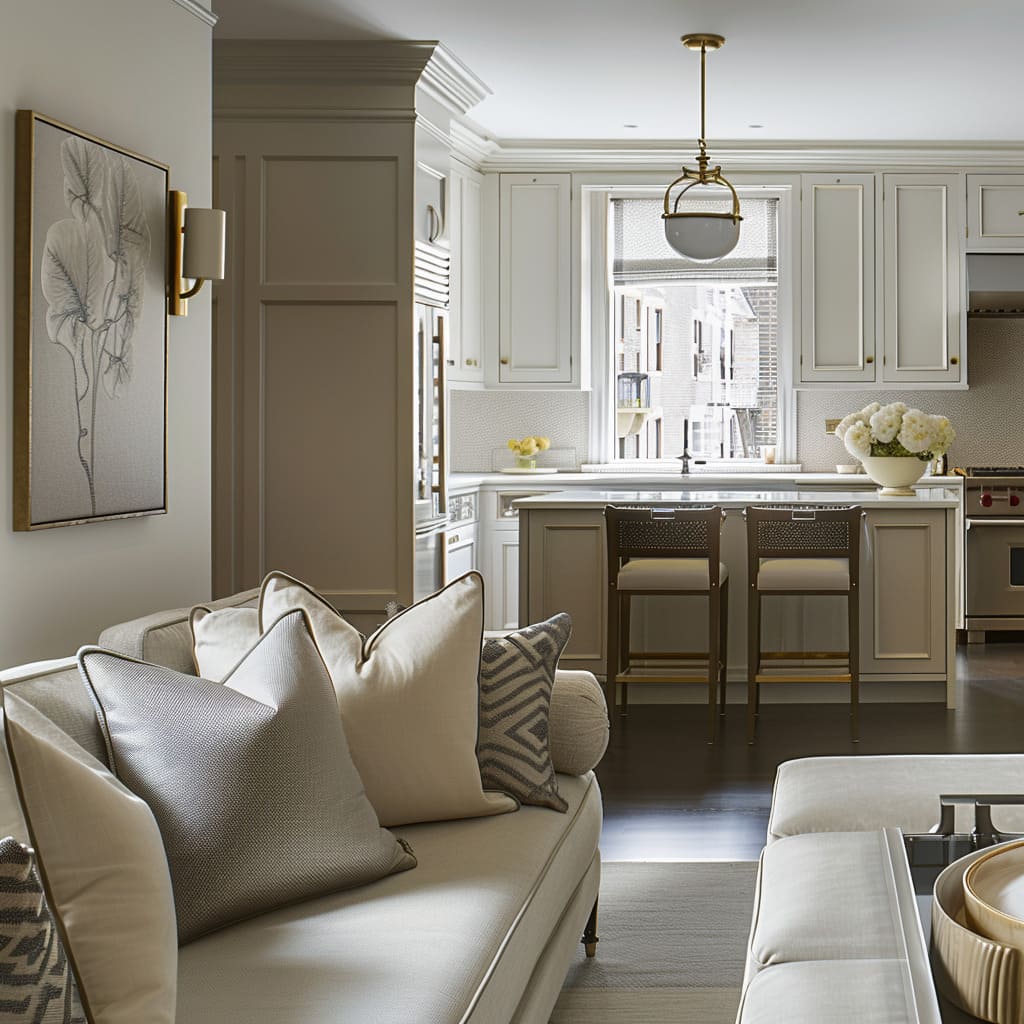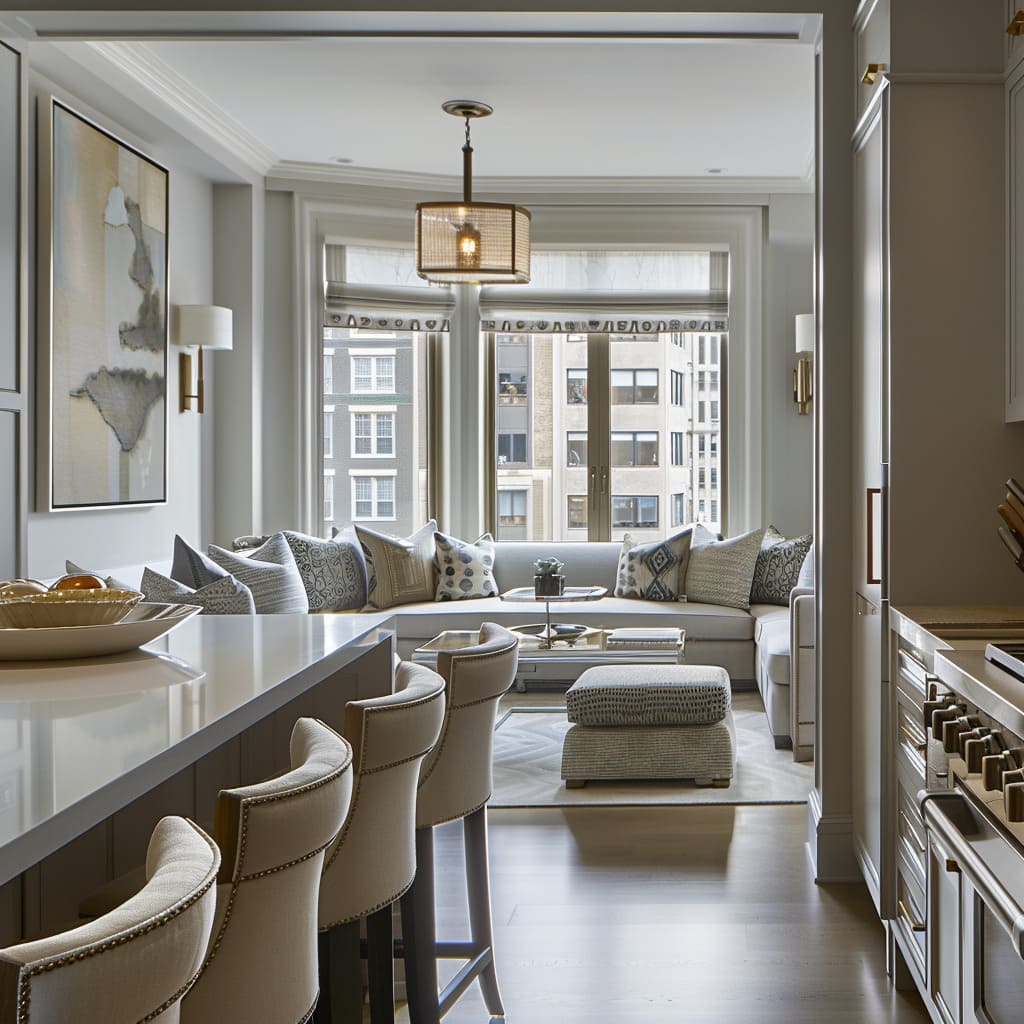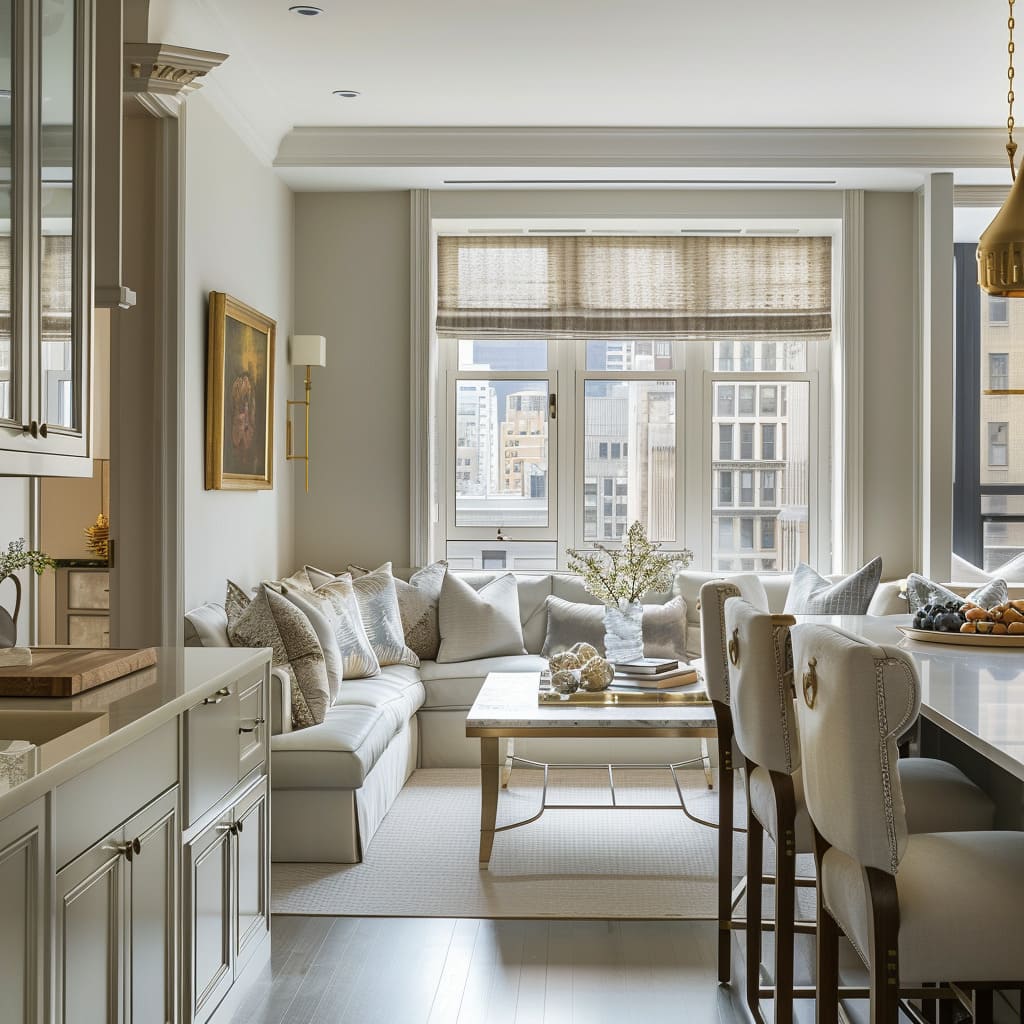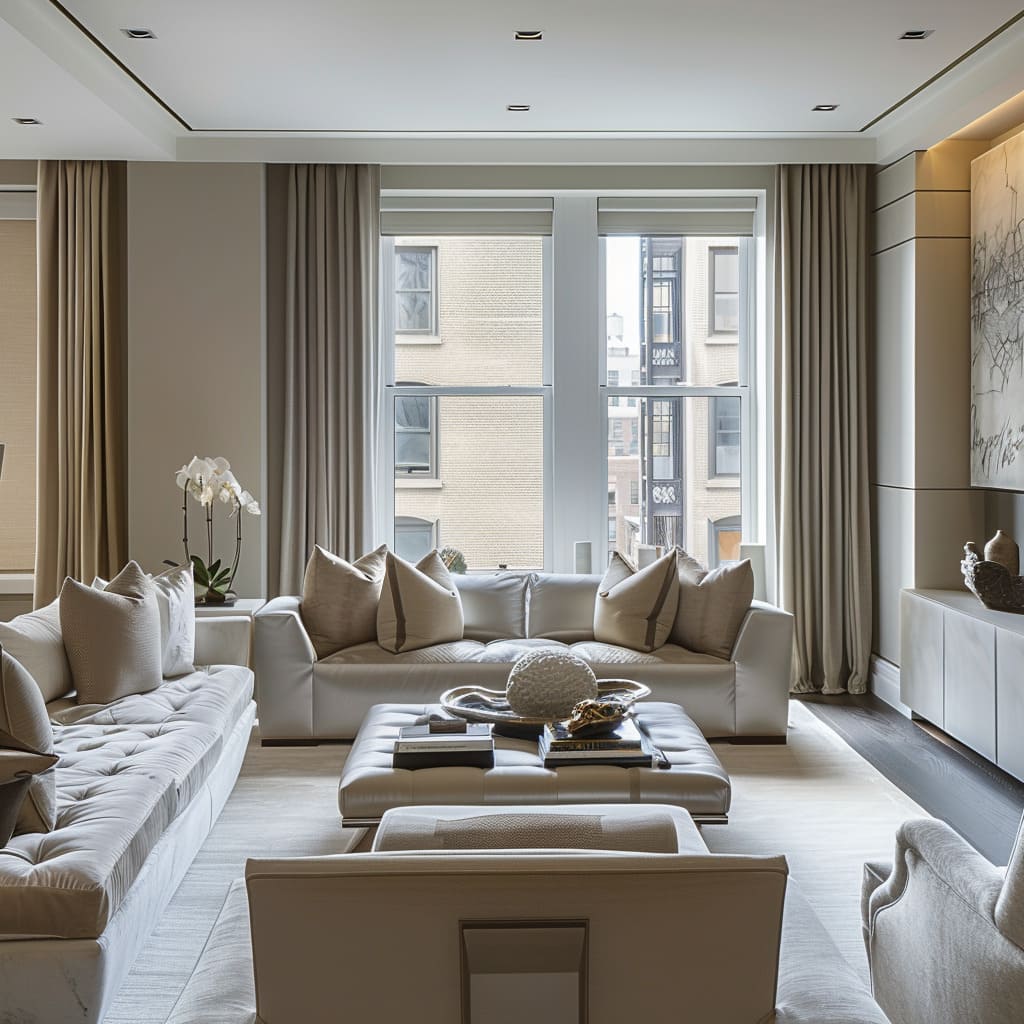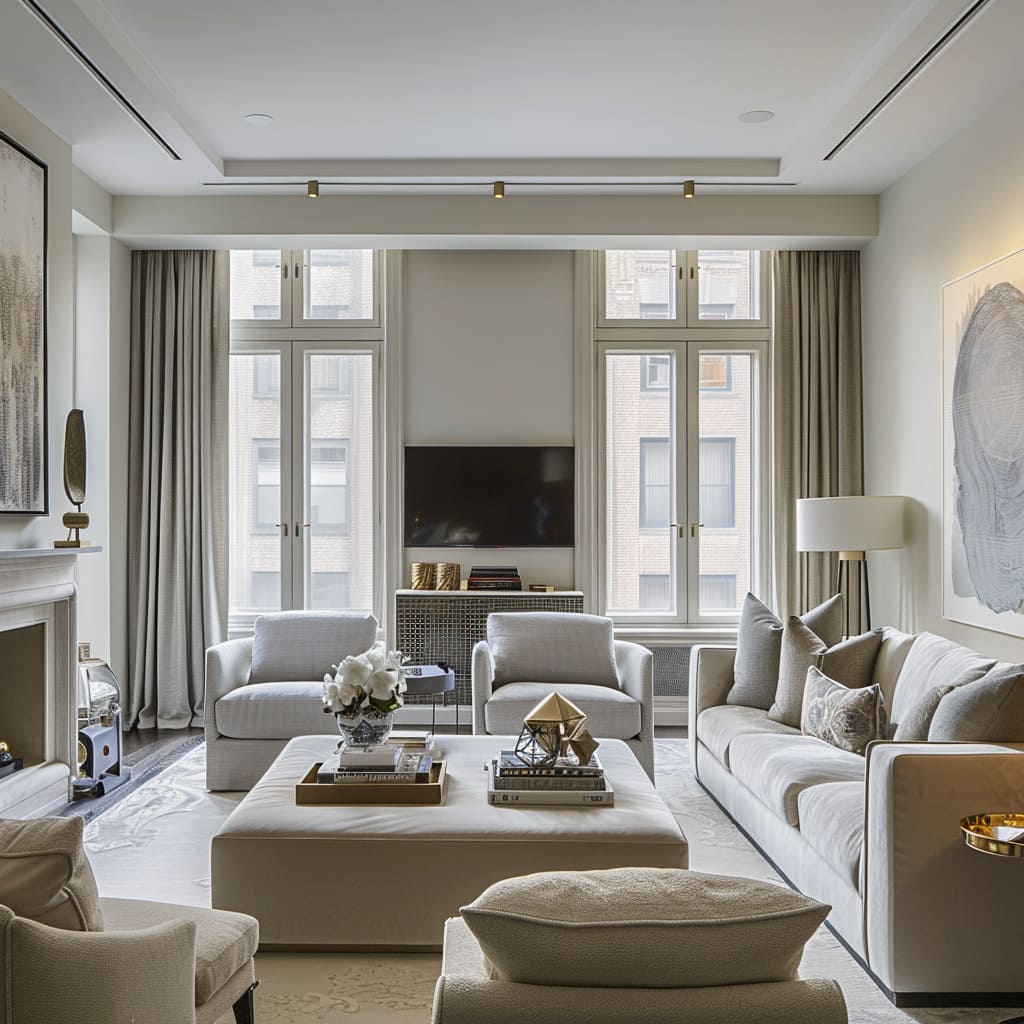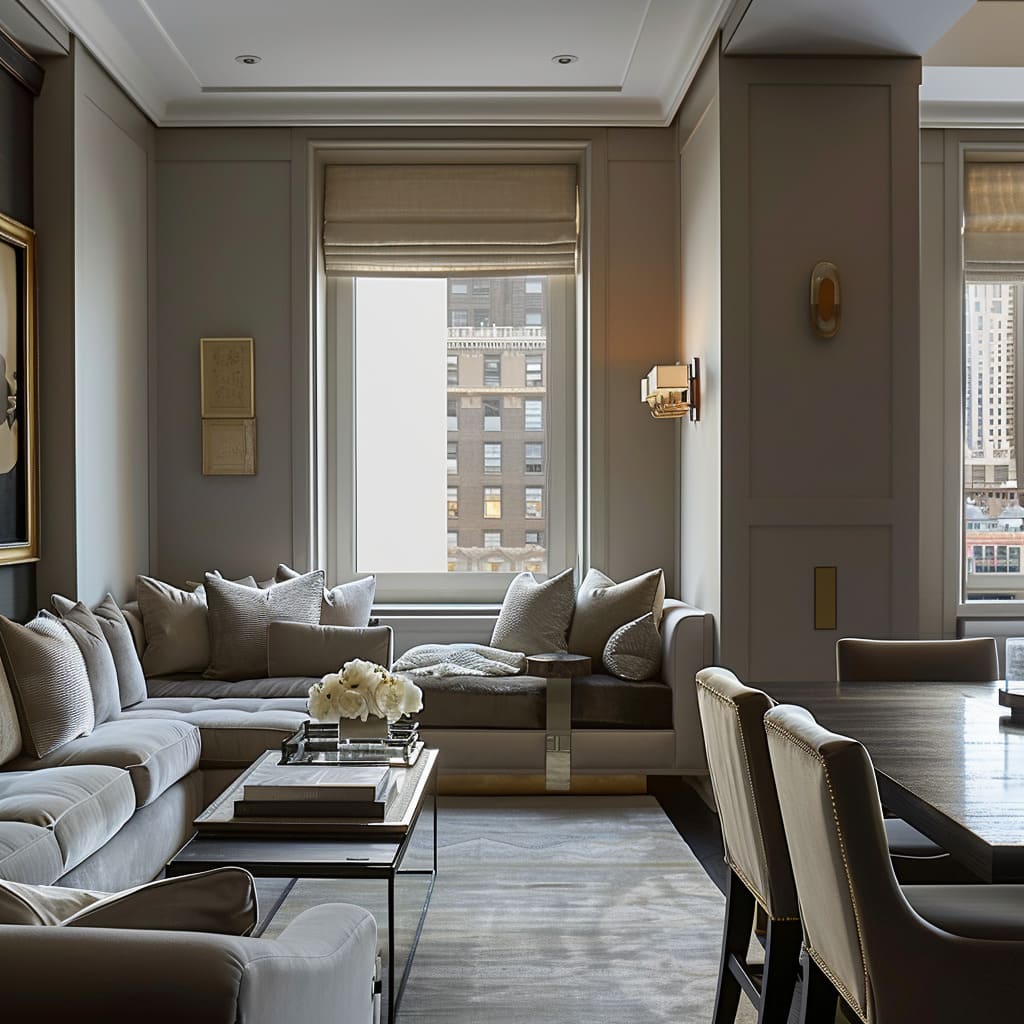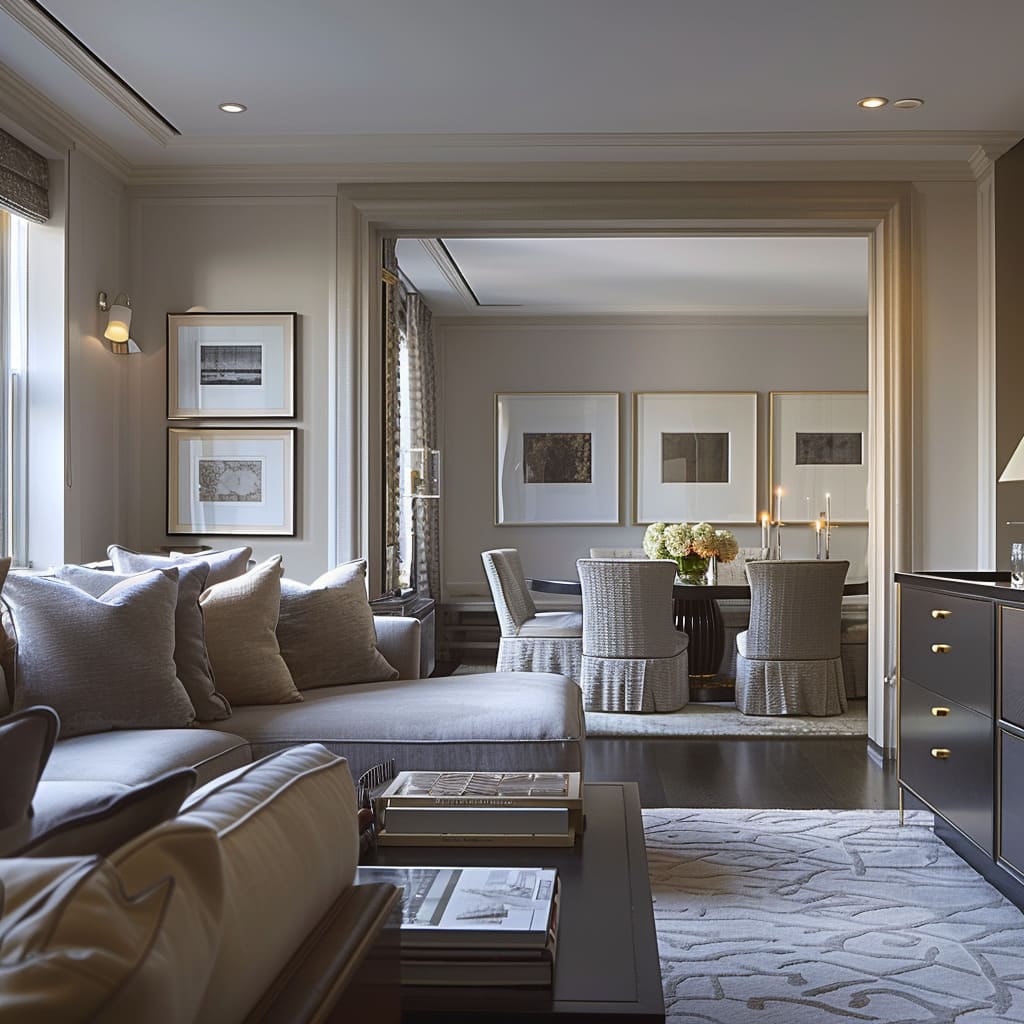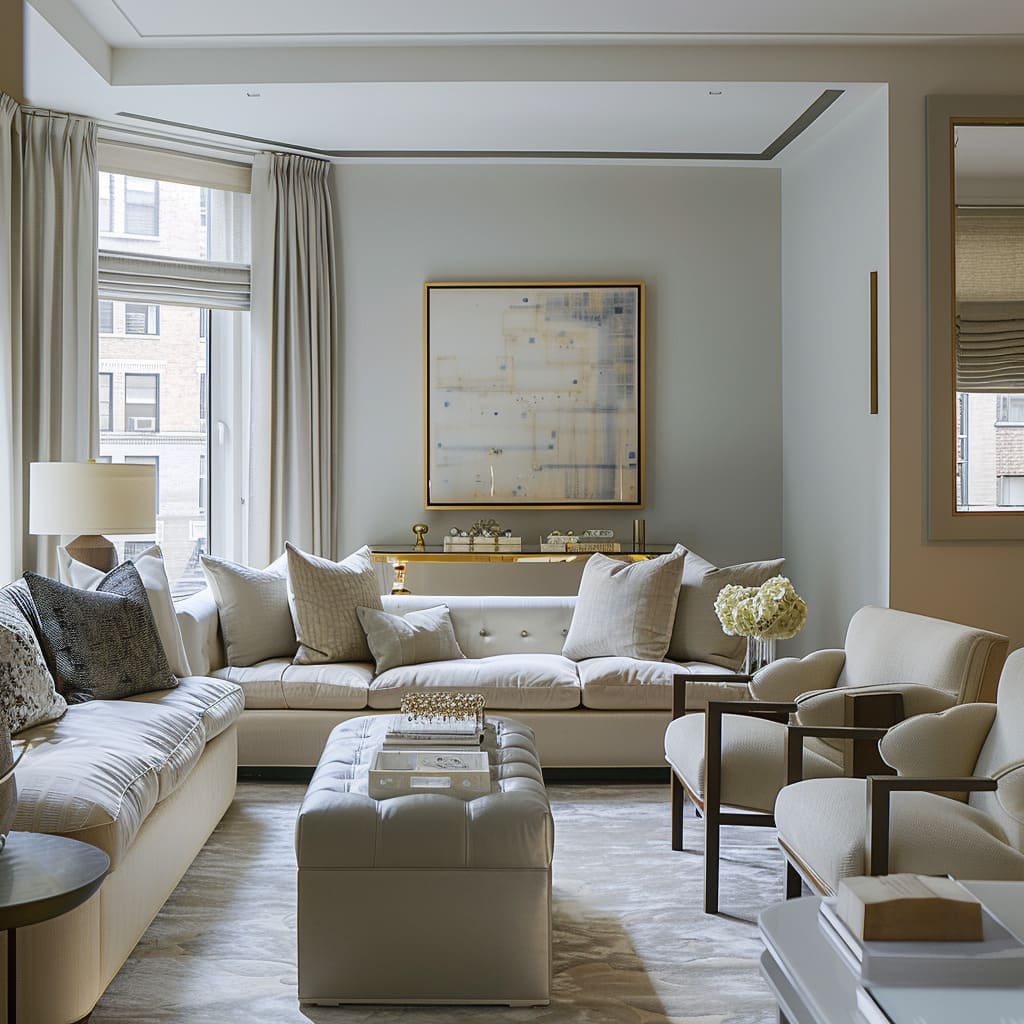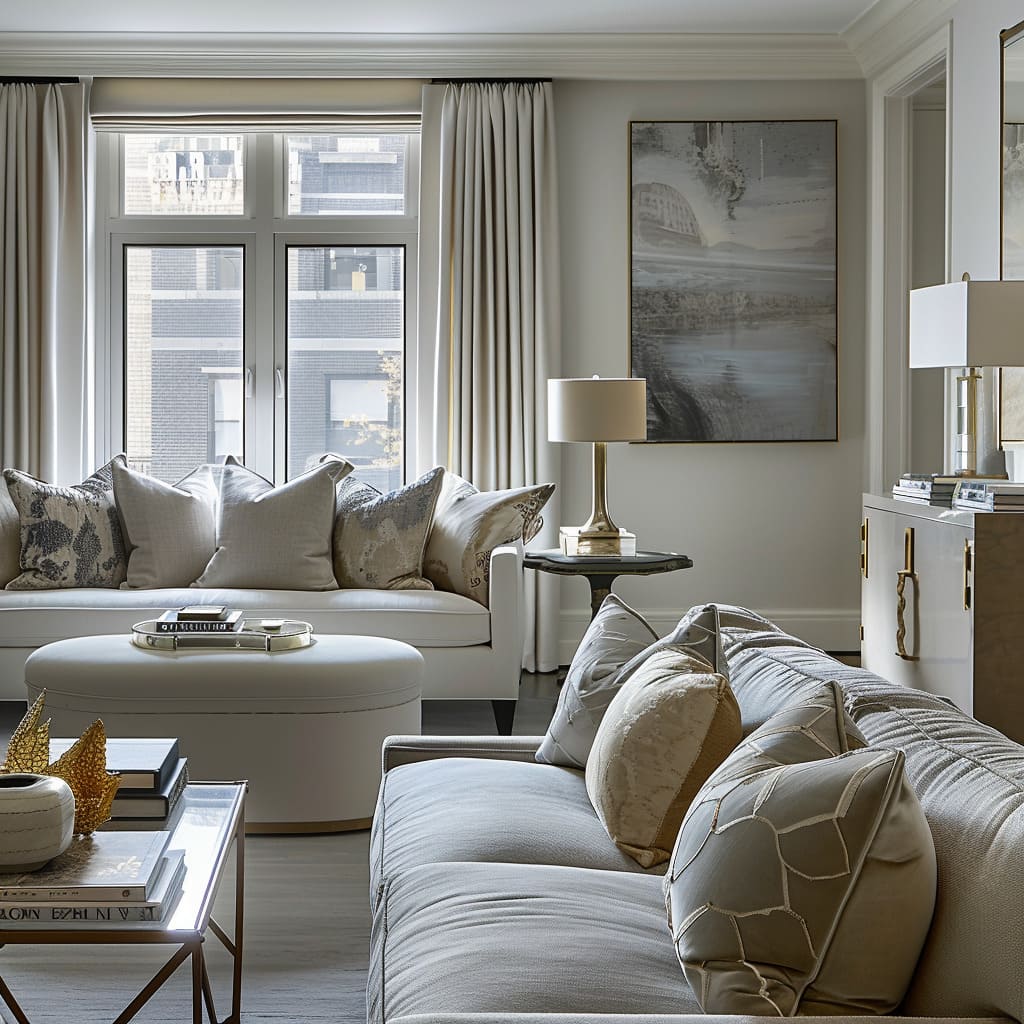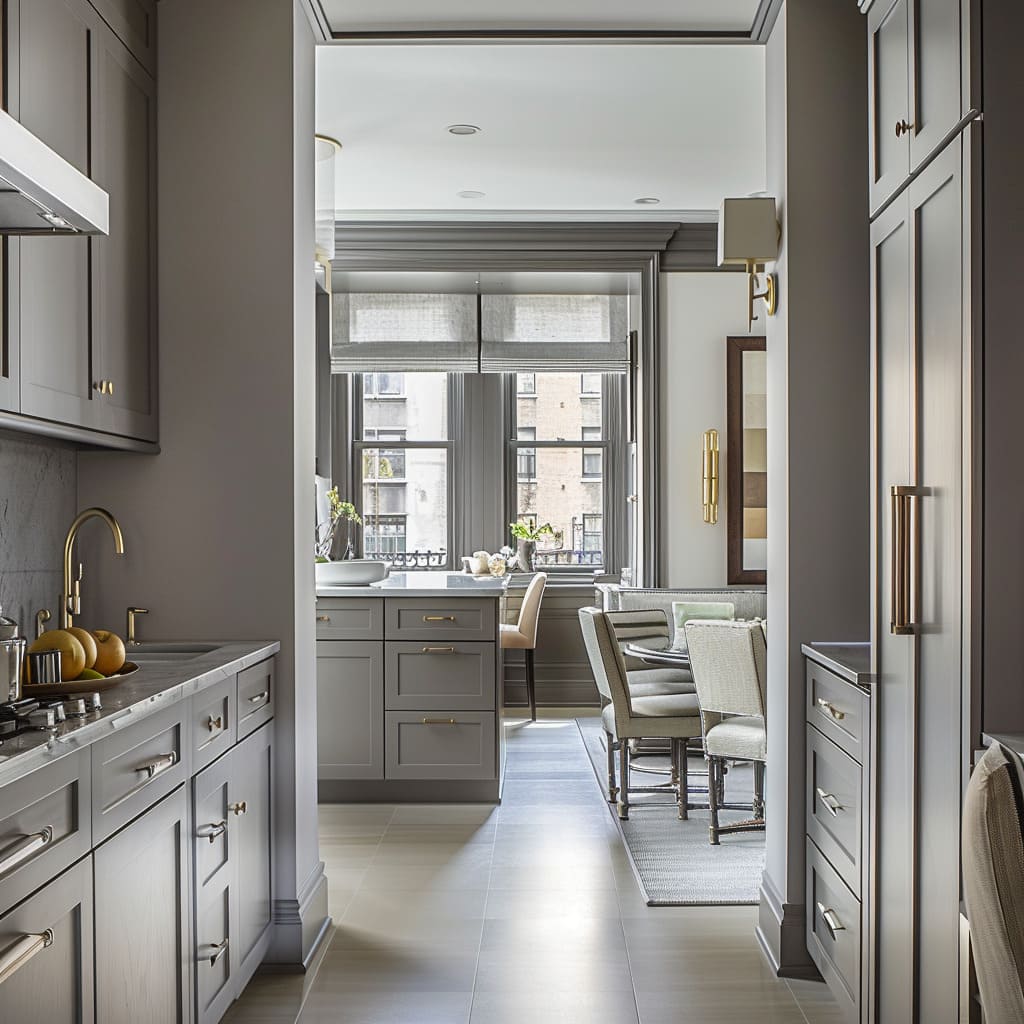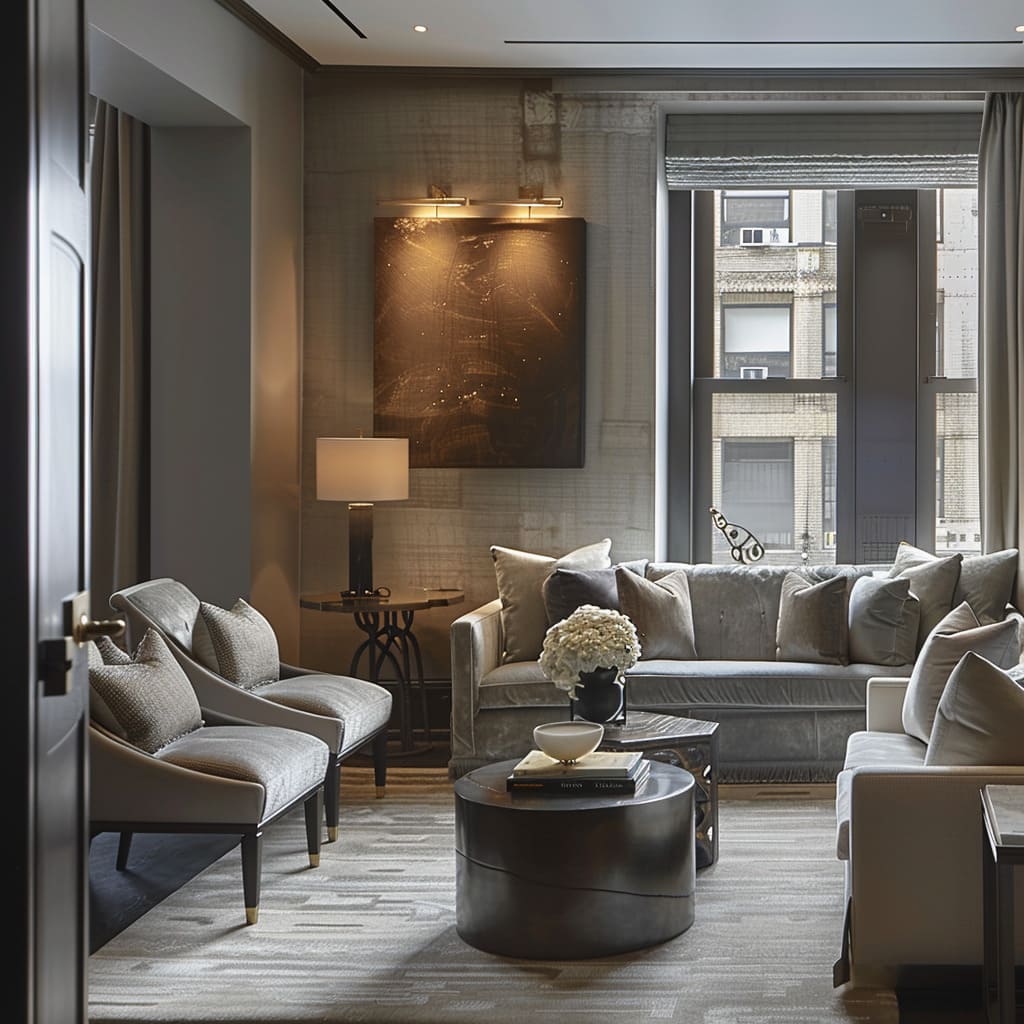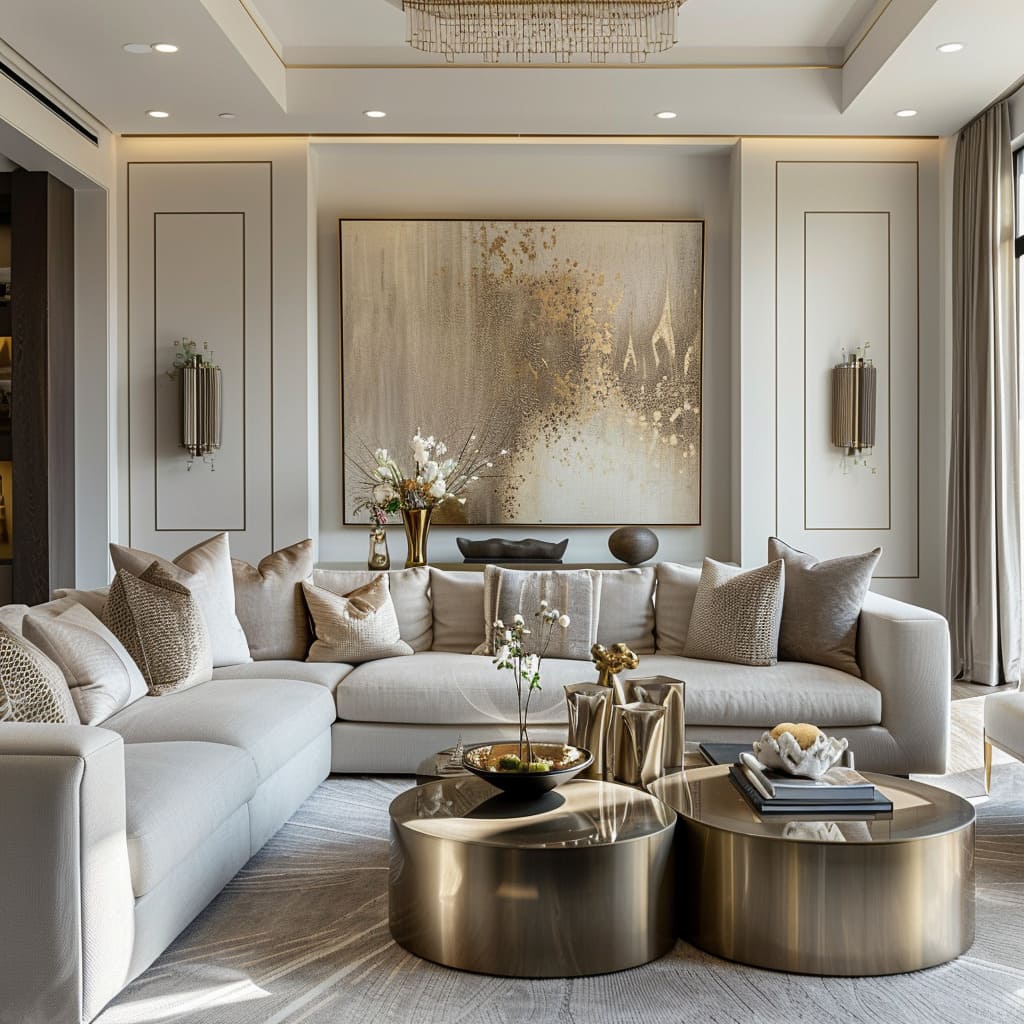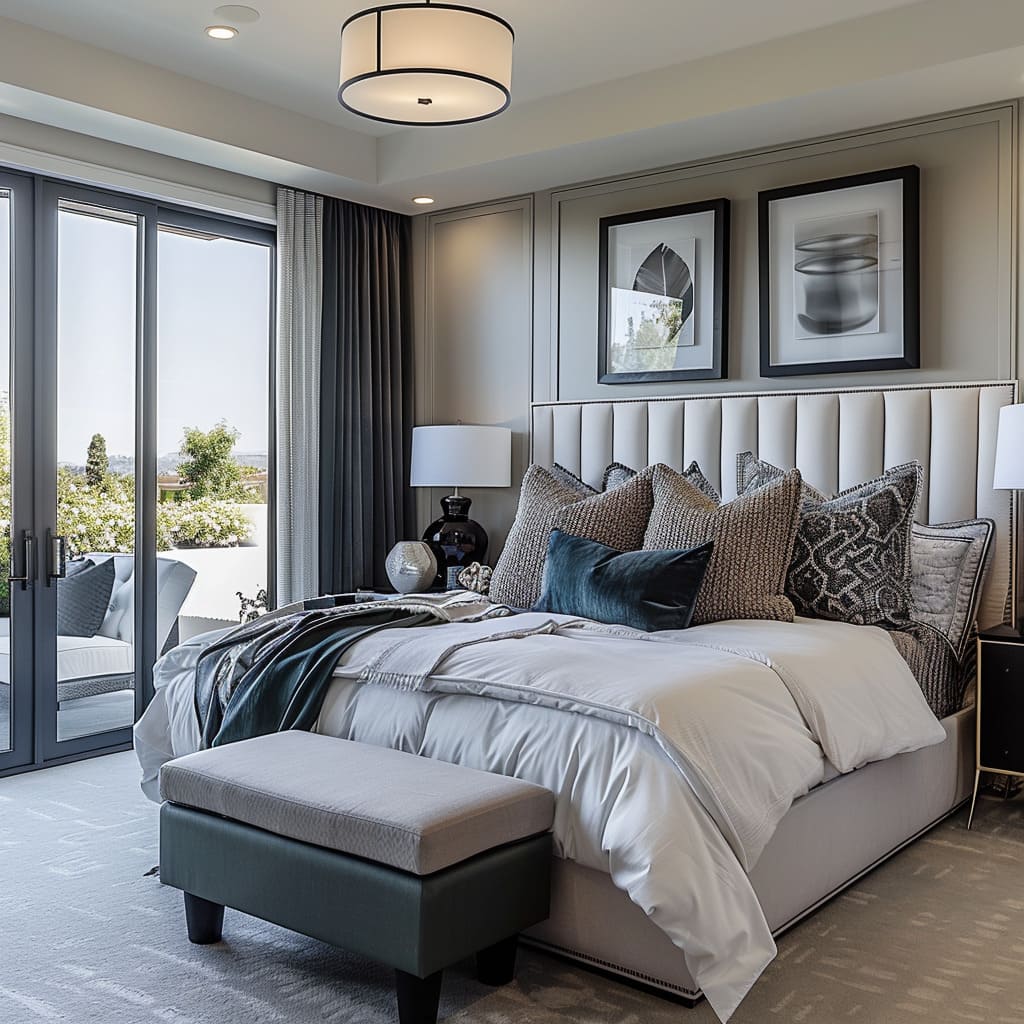Modern Transitional Style is a design approach that strikes a fine balance between the warmth and familiarity of traditional elements and the sleek, clean lines associated with modern design. This style has found a broad appeal, especially in the U.S., where homeowners appreciate its versatility and timelessness.
By blending classic and contemporary pieces, Modern Transitional Style creates spaces that feel both welcoming and current. The key to mastering this style lies in carefully selecting the right furniture. This article will guide you through the process of choosing furniture that not only fits but enhances the Modern Transitional aesthetic
The Foundation of Modern Transitional Style
At the heart of Modern Transitional Style is a restrained and thoughtful color palette. This design approach favors neutral tones—beige, cream, soft gray, and similar shades—that serve as the canvas for the room.
These colors are chosen for their ability to create a calm and inviting atmosphere while allowing the room’s furnishings and accents to take center stage. Walls in a Modern Transitional home are typically painted in light, neutral shades. This choice of color helps to maintain a bright, airy feel in the space, which is essential for creating the open and uncluttered look that defines this style
When it comes to wall treatments, simplicity is key. While bold patterns and colors might be used sparingly in artwork or textiles, the walls themselves are kept understated.
This allows the furniture and decor to shine without competition. In some cases, a subtle texture or a hint of sheen in the paint can add depth without drawing too much attention. The goal is to create a backdrop that enhances the room’s overall design rather than overwhelming it.
Key Furniture Pieces for a Modern Transitional Living Room
The sofa is often the focal point of a living room, making its selection crucial in a Modern Transitional space. Sofas in this style are characterized by their clean lines and tailored appearance.
Upholstery is typically kept in neutral tones—such as cream, beige, or light gray—to maintain the room’s cohesive color scheme. These sofas often feature plush, deep seating, which combines comfort with a polished look.
Sectionals are another popular choice in Modern Transitional living rooms, particularly in larger spaces. These pieces offer ample seating while maintaining the sleek, uncluttered look that is central to the style.
When choosing a sectional, consider one with simple, straight lines and minimal embellishments. The upholstery should be in a neutral shade, but you can introduce texture through the fabric choice—such as linen, velvet, or a subtle weave
Accent pillows play a vital role in tying the sofa or sectional to the rest of the room. While the pillows should stay within the neutral color palette, they can vary in texture and subtle patterns to add depth and interest.
For example, a mix of smooth, woven, and knitted pillows can create a visually appealing arrangement that enhances the room’s layered look.
Accent chairs in a Modern Transitional living room should complement the sofa without overshadowing it. These chairs often feature similar neutral tones and clean lines, creating a sense of harmony in the seating arrangement. When selecting accent chairs, consider designs with simple, yet elegant silhouettes.
The upholstery should be in keeping with the room’s overall color scheme, but you can introduce subtle details such as nailhead trim, tufting, or slightly curved arms to add character
Placement of accent chairs is also important. They should be positioned to create a balanced and inviting seating area, whether flanking a sofa or placed opposite it to encourage conversation. These chairs not only provide additional seating but also contribute to the room’s symmetry and visual appeal.
Coffee tables in a Modern Transitional space are chosen for their ability to balance form and function. The ideal coffee table will have a minimalist design, often featuring materials like marble, glass, or wood with clean lines. Marble-topped tables are particularly popular for adding a touch of luxury while maintaining the understated elegance of the space.
The base of the table might incorporate slim, metallic legs in finishes like brass or blackened steel, which add a subtle contrast without overpowering the room
Side tables serve as both practical and decorative elements in the living room. These tables should echo the materials and finishes used in the coffee table, creating a cohesive look. Brass or metallic accents on side tables add warmth and a hint of glamour.
The design should be simple, allowing the tables to blend seamlessly with the other furniture while still offering a surface for lamps, books, or decorative objects
A well-chosen media console is essential in a Modern Transitional living room, where technology must coexist with design. The best media consoles in this style are those that blend into the background, often finished in soft, neutral tones that match the walls.
This creates a seamless transition from the console to the rest of the room. Clean lines and minimal hardware are key features, ensuring that the console does not draw attention away from other design elements like artwork or sculptures
Storage units and consoles often include subtle metallic accents, such as gold-toned handles or legs, which add a refined touch without disrupting the room’s minimalist aesthetic. These pieces are as functional as they are beautiful, offering ample storage for media equipment, books, and other items that need to be kept out of sight to maintain the room’s uncluttered look.
Complementary Furniture for a Modern Transitional Kitchen
In a Modern Transitional kitchen, the island often serves as the central gathering spot, bridging the gap between the kitchen and living areas.
The design of the island should reflect the same clean, uncluttered lines seen in the living room furniture, with an emphasis on high-quality materials. Marble or quartz countertops are common choices, offering a durable yet elegant surface that echoes the finishes used in the living room’s coffee table or side tables
Bar stools are a critical component of the kitchen island setup. The best stools for this style feature neutral upholstery and slim, elegant frames that align with the room’s overall design.
Upholstered seats in fabrics such as leather or soft woven textiles provide comfort while maintaining a sophisticated look. The stool frames might incorporate metal accents, such as brass or blackened steel, which tie into other metallic elements in the space.
Cabinetry in a Modern Transitional kitchen is all about simplicity and function. Dark or neutral tones are often chosen for their ability to complement the overall color scheme without becoming a focal point.
Brass hardware is a common feature, adding a subtle touch of warmth and luxury. The design of the cabinets should be streamlined, with flat panels and minimal ornamentation
Storage solutions in the kitchen should be both functional and visually appealing. Integrated appliances help maintain the clean lines that are characteristic of Modern Transitional spaces, ensuring that the kitchen feels cohesive with the rest of the home. Open shelving or glass-front cabinets can be used sparingly to display select items, such as decorative plates or glassware, adding a personalized touch without cluttering the space
How does the integration of natural light through large windows in a Modern Transitional kitchen affect the choice of materials and finishes for the cabinetry and countertops?
The integration of natural light through large windows in a Modern Transitional kitchen significantly influences the choice of materials and finishes for the cabinetry and countertops. When a kitchen is flooded with natural light, it enhances the visibility of textures and colors, making the details of materials more pronounced. In such a space, lighter cabinetry finishes, such as soft grays or beiges, may be chosen to reflect the light, creating a bright and airy environment.
This can help to maintain the open, uncluttered feel that is central to Modern Transitional design. On the other hand, the presence of abundant natural light also allows for the use of darker tones in cabinetry without making the space feel too heavy or enclosed. Darker tones like charcoal or deep brown can be used to create contrast with the light flooding in from the windows, adding depth and sophistication to the kitchen’s design. The natural light softens these darker tones, preventing them from overwhelming the space.
For countertops, materials like marble or quartz with light veining can be particularly striking in natural light. The subtle patterns and textures in these materials become more apparent, adding a layer of visual interest that complements the overall aesthetic. The choice of a polished finish on countertops can also amplify the effect of natural light, creating a reflective surface that enhances the kitchen’s brightness and contributes to a sense of spaciousness.
Overall, natural light allows for greater flexibility in the selection of materials and finishes, enabling a balance between light and dark elements that is essential to achieving the refined, cohesive look characteristic of Modern Transitional kitchens.
In a Modern Transitional kitchen, how might the design and placement of pendant lighting above the island enhance or contrast with the metallic accents found in the stool frames and cabinet hardware?
In a Modern Transitional kitchen, the design and placement of pendant lighting above the island can play a crucial role in either enhancing or creating contrast with the metallic accents found in the stool frames and cabinet hardware. Pendant lighting often serves as a focal point, drawing the eye toward the island, which is typically the central gathering spot in the kitchen. The choice of pendant design—whether it features metallic finishes like brass, blackened steel, or chrome—can either echo or contrast with the other metallic elements in the space.
When pendant lights share the same finish as the stool frames and cabinet hardware, such as brass or blackened steel, it creates a cohesive and unified look. This approach ties together the different elements of the kitchen, reinforcing the room’s overall aesthetic and ensuring that no single feature feels out of place. The consistent use of the same metallic finish throughout the space can also make the kitchen feel more polished and deliberate.
On the other hand, if the pendant lighting is designed to contrast with the metallic accents in the stools and hardware, it can introduce a dynamic visual interest that adds depth to the kitchen’s design. For example, if the stools and hardware feature a warm brass finish, selecting pendant lights with a cooler metallic finish, such as brushed nickel or matte black, can create a striking contrast that draws attention to the island. This contrast can also serve to highlight the individual design elements, making each stand out more prominently within the space.
The placement of pendant lights is equally important. Ideally, pendants should be positioned to evenly illuminate the island while also highlighting the finishes on the stools and countertops. The height at which the pendants are hung can affect how the light interacts with these metallic surfaces, either emphasizing their shine and texture or softening their impact.
Overall, the design and placement of pendant lighting in a Modern Transitional kitchen offer a unique opportunity to either harmonize with or contrast against the metallic accents, allowing homeowners to customize the room’s ambiance and visual balance to their personal preferences.
When selecting rugs and flooring for a Modern Transitional kitchen, what considerations should be made to ensure they harmonize with the neutral tones and textures of the cabinetry and bar stools while maintaining the overall aesthetic of the living spaces?
When selecting rugs and flooring for a Modern Transitional kitchen, several key considerations must be made to ensure they harmonize with the neutral tones and textures of the cabinetry and bar stools while maintaining the overall aesthetic of the living spaces. The first consideration is the color palette. The flooring should complement the neutral tones of the cabinetry, such as soft grays, beiges, or light browns, creating a cohesive look that ties the kitchen together with adjacent living areas.
Choosing a flooring color that is slightly lighter or darker than the cabinetry can add subtle contrast without disrupting the flow of the space.
Texture is another important factor. The flooring should have a texture that complements the smooth or matte finishes of the cabinetry and the soft upholstery of the bar stools. For example, a lightly textured wood or stone floor can add warmth and depth, enhancing the tactile experience of the kitchen without overwhelming the neutral tones.
If the cabinetry and stools feature clean, sleek surfaces, a slightly textured rug or runner can introduce a contrasting element that adds interest without clashing with the overall design.
Material choice is critical as well. The flooring should be durable and easy to maintain, especially in a high-traffic area like the kitchen. Natural materials, such as hardwood or stone, are often preferred in Modern Transitional kitchens for their timeless appeal and ability to harmonize with various textures. These materials can also help to bridge the kitchen with the living spaces, ensuring a smooth transition between different areas of the home.
When it comes to rugs, the selection should focus on adding softness and comfort underfoot without detracting from the clean lines and neutral tones of the kitchen. A rug or runner in a subtle pattern or solid color that matches or complements the cabinetry can enhance the kitchen’s design while maintaining the simplicity that defines Modern Transitional style. Rugs with minimal patterns or those that incorporate subtle geometric designs can add a touch of interest without competing with the other elements in the room.
Finally, consider the size and placement of rugs and flooring transitions. Rugs should be appropriately sized to define specific areas, such as the space in front of the sink or the seating area at the island, without interrupting the flow of movement. Flooring transitions between the kitchen and living areas should be smooth and seamless, using similar materials or complementary tones to maintain the visual continuity of the space. In summary, when selecting rugs and flooring for a Modern Transitional kitchen, the key is to choose materials, colors, and textures that enhance the neutral tones of the cabinetry and bar stools while ensuring that the overall aesthetic remains cohesive with the adjoining living spaces.
Textiles and Rugs in Modern Transitional Spaces
Textiles are a key element in creating a comfortable and inviting Modern Transitional space. Fabrics should be soft and luxurious, contributing to the room’s overall sense of warmth without disrupting its clean lines. Upholstery fabrics like linen, cotton, and velvet are popular choices for their durability and tactile appeal.
Neutral tones dominate, with an emphasis on texture rather than pattern. For example, a smooth velvet sofa paired with a chunky knit throw can create a pleasing contrast that adds depth to the design.
Drapes and curtains should be chosen with the same care as upholstery fabrics. Floor-to-ceiling drapes in light, airy fabrics such as linen or silk help frame the windows and enhance the room’s natural light.
The color of the drapes should complement the walls and furniture, creating a seamless flow throughout the space. While patterns are generally avoided in Modern Transitional design, a subtle weave or texture in the fabric can add interest without detracting from the overall aesthetic
Rugs play a vital role in defining areas within an open-plan Modern Transitional home. Large area rugs in neutral tones help anchor the seating arrangement, adding warmth and comfort underfoot. The design of the rug should be understated, with muted patterns or textures that add depth without overwhelming the space.
For example, a rug with a subtle geometric pattern in shades of beige and cream can add visual interest while maintaining the room’s cohesive look.
The flooring in a Modern Transitional home is typically light wood or a similar neutral tone that complements the overall color scheme. The choice of flooring should enhance the room’s natural light and contribute to the clean, uncluttered feel of the space.
A light, natural wood floor adds warmth and texture while providing a durable foundation for the room’s design.
How does the use of natural wood flooring in a Modern Transitional living room interact with large windows and abundant natural light, and what impact does this have on the overall ambiance of the space?
The use of natural wood flooring in a Modern Transitional living room plays a significant role in shaping the room’s ambiance, particularly when combined with large windows and abundant natural light. Natural wood flooring, with its warm tones and organic texture, serves as a grounding element in the space, adding warmth and a sense of continuity throughout the room. When large windows allow for an influx of natural light, the wood flooring comes to life, as the light enhances the grain and subtle variations in color, making the floor appear even more vibrant and dynamic
The interaction between the wood flooring and natural light contributes to a bright and airy atmosphere, which is a hallmark of the Modern Transitional style. The light wood tones help to reflect the sunlight, rather than absorbing it, which keeps the room feeling open and spacious. This is particularly important in a style that values an uncluttered, harmonious look.
The combination of light wood floors and natural light ensures that the room does not feel heavy or overly formal, but rather inviting and comfortable
Furthermore, the natural light enhances the overall texture of the wood flooring, making it a subtle focal point that adds depth to the room without overwhelming other design elements. As the light changes throughout the day, it casts different shadows and highlights on the wood, which can create a dynamic, ever-changing environment that adds to the room’s appeal
The overall impact of using natural wood flooring in a living room with large windows is a space that feels balanced and cohesive, where the warmth of the wood and the brightness of the natural light work together to create an inviting and comfortable atmosphere. This interaction supports the Modern Transitional style’s goal of blending traditional warmth with modern simplicity, making the room feel both timeless and contemporary.
When incorporating floor-to-ceiling drapes in a Modern Transitional living room, how does the choice of fabric and its interaction with light affect the visual relationship between the drapes and key furniture pieces like the sectional sofa or armchairs?
When incorporating floor-to-ceiling drapes in a Modern Transitional living room, the choice of fabric and its interaction with light play crucial roles in establishing the visual relationship between the drapes and key furniture pieces like the sectional sofa or armchairs.
The fabric chosen for the drapes can either complement or contrast with the textures and tones of the furniture, significantly influencing the room’s overall harmony and balance.
Light, airy fabrics such as linen or silk are popular choices in Modern Transitional spaces because they enhance the room’s natural light, creating a soft, diffused glow. When sunlight filters through these fabrics, it can create a gentle, ambient effect that highlights the smooth textures of the sectional sofa or armchairs, tying the drapes and furniture together in a cohesive visual narrative. For example, if the sectional sofa is upholstered in a smooth, neutral-toned fabric, drapes made of a similar lightweight material can reinforce the room’s airy, serene atmosphere, allowing the furniture and drapes to blend seamlessly into the design
On the other hand, the interaction between the drapes and light can also create contrasts that add depth and interest to the room. If the sectional sofa or armchairs are upholstered in a heavier, textured fabric like velvet, choosing drapes with a subtle weave or a slightly contrasting texture can enhance this relationship. The light that passes through or reflects off the drapes can accentuate the tactile quality of the furniture, making the textures of both the drapes and the upholstery more pronounced and engaging
The color of the drapes also affects how they interact with the furniture and light. Drapes in a lighter shade than the furniture can help brighten the space, making the room feel larger and more open. This is especially effective when the drapes are paired with a darker sectional sofa or armchairs, as the contrast can highlight the furniture as a focal point while still maintaining a cohesive look.
Conversely, drapes in a color that closely matches the furniture can create a more unified and subtle aesthetic, where the drapes and furniture blend into a singular visual plane, making the room feel more streamlined
Overall, the choice of fabric and its interaction with light are essential in determining how floor-to-ceiling drapes relate to the key furniture pieces in a Modern Transitional living room. By carefully selecting fabrics that complement or contrast with the furniture, and considering how light will interact with these elements, you can create a space that feels balanced, inviting, and visually harmonious
In a Modern Transitional living room with neutral-toned textiles and rugs, how do elements like a marble coffee table or metallic accent pieces contribute to the overall texture and visual balance of the space?
In a Modern Transitional living room with neutral-toned textiles and rugs, elements like a marble coffee table or metallic accent pieces play a pivotal role in enhancing the overall texture and visual balance of the space. These elements introduce layers of contrast and sophistication that elevate the room’s aesthetic, making it both dynamic and cohesive.
A marble coffee table, with its smooth, polished surface and natural veining, adds a striking textural contrast to the soft, plush textiles and rugs. The sleekness of the marble creates a sense of refinement, while the organic patterns in the stone bring a touch of natural beauty that complements the neutral tones of the surrounding fabrics. This interplay between the hard, glossy surface of the marble and the softer textures of the textiles adds depth to the room, preventing the neutral palette from feeling flat or monotonous.
The marble table often becomes a focal point, anchoring the seating area with its visual weight and providing a luxurious counterbalance to the more subdued elements in the room
Metallic accent pieces, such as brass or blackened steel side tables, lamp bases, or decorative objects, further contribute to the room’s textural diversity. These accents introduce a subtle sheen that catches the light, adding a layer of visual interest without overwhelming the space. The reflective quality of metallics contrasts beautifully with the matte finishes of the textiles, creating a harmonious blend of textures that enriches the overall design.
For example, brass accents can add warmth and a touch of opulence, while blackened steel offers a more contemporary and understated elegance
The placement and choice of these elements are crucial in maintaining the room’s visual balance. By strategically positioning the marble coffee table and metallic accents, you can create a sense of symmetry and order that enhances the room’s cohesive feel. For instance, pairing a marble table with metallic side tables on either side of a neutral-toned sofa can create a balanced, well-proportioned look that draws the eye across the space, making it feel more connected and thoughtfully arranged
In essence, marble and metallic elements in a Modern Transitional living room do more than just add visual interest—they also contribute to the overall texture and balance of the space. These pieces introduce contrast, reflectivity, and a touch of luxury, all while harmonizing with the neutral tones of the textiles and rugs. This careful blending of materials and textures ensures that the room feels layered, sophisticated, and inviting
Decorative Accents and Artwork
Artwork in a Modern Transitional space serves as both a focal point and a complement to the room’s design. Large, abstract pieces in neutral tones are particularly effective in this style, adding depth and sophistication without overpowering the space. The choice of artwork should reflect the room’s color palette, with hints of metallics or subtle patterns that echo other design elements.
When selecting artwork, consider the size and placement carefully. A large piece of art above a media console or sofa can help anchor the room, drawing the eye and adding balance to the space. The framing should be simple, often in metallic finishes that tie into the room’s hardware and lighting fixtures.
Decorative accents in a Modern Transitional room should be chosen for their ability to enhance the space without adding clutter. Vases, sculptures, and trays in metallic tones such as gold or brass add a touch of luxury and warmth. These pieces should be carefully arranged to create a sense of balance and harmony in the room.
Fresh flowers or plants in simple vases bring a natural element into the space, adding life and vibrancy. These elements should be used sparingly to avoid disrupting the room’s clean lines and minimalist aesthetic. The goal is to add interest and personality without overwhelming the space
How does the inclusion of natural elements, such as fresh flowers or plants in simple vases, interact with large windows and natural light to enhance the overall ambiance and visual connection between the interior and the exterior in a Modern Transitional living room?
The inclusion of natural elements, such as fresh flowers or plants in simple vases, plays a significant role in enhancing the overall ambiance and visual connection between the interior and the exterior in a Modern Transitional living room. These natural elements act as a bridge between the indoor space and the outdoors, especially when large windows allow abundant natural light to flood the room. The light filtering through the windows highlights the vibrant colors and organic textures of the plants or flowers, making them stand out against the more neutral tones of the room’s furnishings and decor
The interaction between these natural elements and natural light creates a dynamic, ever-changing visual experience. As the light shifts throughout the day, it casts different shadows and highlights on the plants, bringing a sense of life and movement to the space. This interaction not only enhances the visual appeal of the room but also reinforces a connection to the natural world outside the windows
Moreover, the presence of fresh flowers or plants near large windows creates a seamless flow between the interior and exterior environments. The greenery inside the room can mirror the landscape outside, especially if the view includes trees, gardens, or other natural scenes. This continuity helps to blur the boundaries between indoors and outdoors, making the living room feel more expansive and integrated with its surroundings.
In addition to their aesthetic contribution, natural elements bring a sense of freshness and vitality to the room. The simple vases that hold these plants or flowers contribute to the minimalist aesthetic typical of Modern Transitional design, ensuring that the natural elements enhance the space without adding visual clutter. The understated design of the vases allows the beauty of the plants themselves to be the focal point, further strengthening the connection to nature
Overall, the inclusion of fresh flowers or plants in a Modern Transitional living room, combined with large windows and natural light, creates a harmonious and balanced environment that feels both connected to and reflective of the natural world outside. This integration of nature into the interior space not only elevates the room’s ambiance but also fosters a sense of tranquility and continuity between the interior design and the exterior landscape
In what ways do large abstract art pieces in neutral tones impact the relationship between the soft textures of upholstery fabrics and the more structured elements, such as a marble coffee table or metallic accents, in a Modern Transitional living room?
Large abstract art pieces in neutral tones significantly influence the relationship between the soft textures of upholstery fabrics and the more structured elements, such as a marble coffee table or metallic accents, in a Modern Transitional living room. These art pieces serve as visual anchors that help to unify the various elements in the space, creating a cohesive aesthetic that balances softness with structure.
The neutral tones in the artwork often reflect or complement the shades found in the upholstery fabrics, such as creams, beiges, or soft grays. This mirroring of colors helps to tie the room together, ensuring that the artwork feels integrated with the overall design rather than standing apart from it. By echoing the hues of the fabrics, the abstract art reinforces the room’s color palette, making the transitions between different textures—such as from the softness of a plush sofa to the hardness of a marble coffee table—feel seamless and intentional
Moreover, the abstract nature of the art introduces an element of fluidity and movement that contrasts with the structured lines of the furniture. While the upholstery fabrics contribute to a sense of warmth and comfort, the marble coffee table and metallic accents provide a more rigid, defined presence in the room. The abstract art, with its lack of defined shapes and its flowing forms, acts as a mediator between these two types of textures.
It softens the impact of the hard surfaces and adds depth to the soft fabrics, creating a harmonious blend of tactile and visual experiences
The presence of abstract art also adds a layer of sophistication and complexity to the space. Its neutral tones ensure that it does not overpower the room, but rather enhances the subtle contrasts between different materials and finishes. For instance, the sleek surface of a marble coffee table might reflect light in a way that draws attention to the texture of the nearby upholstery, while the art piece above might echo this interaction in a more abstract, less literal form.
This interplay between the various elements—art, fabric, and structure—adds depth and richness to the overall design
In essence, large abstract art pieces in neutral tones act as a bridge between the soft and structured elements in a Modern Transitional living room. They create a visual link that enhances the room’s cohesiveness, while also introducing a dynamic element that enriches the interaction between different textures and materials. This thoughtful integration of art into the space ensures that the room feels balanced, inviting, and aesthetically engaging.
When arranging decorative accents like vases and sculptures in a Modern Transitional living room, how does the careful placement of these items affect the visual balance between the large, anchoring pieces of furniture, such as the sofa and media console, and the more subtle design elements like wall art or lighting fixtures?
When arranging decorative accents like vases and sculptures in a Modern Transitional living room, careful placement plays a crucial role in achieving visual balance between the large, anchoring pieces of furniture—such as the sofa and media console—and the more subtle design elements like wall art or lighting fixtures. These accents act as intermediary elements that help to connect and harmonize the different components of the room, ensuring that the space feels cohesive and well-composed.
The placement of vases and sculptures is key to guiding the eye across the room, creating a sense of flow that ties together the larger furniture pieces with the smaller, more delicate elements. For example, placing a sculpture on a media console can draw attention to the console itself while also linking it visually to any nearby artwork or lighting fixtures. This connection helps to prevent the large furniture pieces from feeling isolated, integrating them into the overall design narrative of the room.
Vases and sculptures can also be used to introduce height variation, which is important in maintaining visual interest and balance. By varying the heights of these decorative items, you can create a dynamic interplay between the horizontal planes of furniture surfaces and the vertical lines of wall art or tall lighting fixtures. For instance, a tall vase on a coffee table can draw the eye upwards, leading it towards a nearby piece of wall art or a pendant light, thereby creating a layered visual effect that adds depth and dimension to the room
The choice of materials and finishes for these accents also plays a significant role in achieving balance. In a Modern Transitional space, where metallic accents and natural materials like marble are often present, selecting vases or sculptures with complementary finishes—such as brass, blackened steel, or stone—can enhance the cohesion between the various elements. For instance, a brass vase on a side table can echo the metallic tones of nearby lighting fixtures, reinforcing the room’s overall color palette and textural theme
Moreover, the careful placement of decorative accents helps to balance the visual weight of the larger furniture pieces. Large items like a sofa or media console can dominate a space if not counterbalanced by thoughtfully placed accents. By strategically positioning vases or sculptures near these larger pieces, you can create focal points that distribute attention evenly across the room, preventing any single element from overwhelming the space.
For example, a cluster of small sculptures on a console can draw attention away from the bulk of a large sofa, creating a more balanced and harmonious look
In summary, the careful placement of decorative accents like vases and sculptures in a Modern Transitional living room significantly affects the visual balance of the space. These items help to connect and integrate the large, anchoring furniture pieces with the more subtle design elements, ensuring that the room feels cohesive, dynamic, and well-balanced. Through thoughtful arrangement and selection, these accents can enhance the overall aesthetic, adding layers of interest and sophistication to the living room.
Lighting Choices to Enhance Modern Transitional Design
Lighting in a Modern Transitional home is both functional and decorative. Ambient lighting, such as recessed ceiling lights or floor lamps, provides general illumination while enhancing the room’s overall atmosphere. The design of these fixtures should be simple, with clean lines and finishes that complement the room’s other elements.
For example, floor lamps with sleek metal bases and soft white shades provide a warm glow without drawing attention away from the room’s furnishings. Task lighting, such as reading lamps or under-cabinet lights, should be integrated seamlessly into the room’s design. These fixtures are chosen for their ability to provide focused light where needed without disrupting the room’s overall aesthetic. The design should be minimal, with an emphasis on function and subtlety.
Feature lighting, such as wall sconces or pendant lights, adds a decorative element to the room while providing additional light. In a Modern Transitional space, these fixtures often feature metallic finishes like brass or blackened steel, which add a touch of warmth and sophistication. The design of the fixtures should be simple, allowing the materials and finishes to stand out.
Wall sconces are particularly effective in highlighting artwork or architectural features, while pendant lights are often used in kitchens or dining areas to add a modern touch. The placement of these fixtures is key, as they should enhance the room’s design without overwhelming it.
Final Thoughts on Curating the Perfect Modern Transitional Space
The key to achieving a successful Modern Transitional design is finding the right balance between traditional and modern elements. This balance is reflected in every choice, from the color palette to the furniture and decor. The goal is to create a space that feels both current and timeless, where classic design principles are updated with modern touches.
When selecting furniture, focus on pieces that combine comfort with clean lines. The upholstery should be in neutral tones, with an emphasis on texture rather than pattern. Decorative accents should be chosen for their ability to enhance the room’s overall aesthetic without adding clutter.
When curating a Modern Transitional space, it’s important to consider the scale and proportions of each piece. The furniture should fit comfortably within the room, allowing for ample space to move around and enjoy the space. Quality and craftsmanship are also key, as these elements ensure that the furniture will stand the test of time
For those who may be unsure of where to start, consider seeking the advice of a professional designer. They can help guide the selection process, ensuring that each piece contributes to the overall look and feel of the space.
Conclusion
Choosing the right furniture for a Modern Transitional home is all about balance and thoughtful curation. By focusing on clean lines, neutral tones, and a mix of textures, you can create a space that is both stylish and inviting. This style offers the perfect blend of classic and contemporary, making it a timeless choice for any home.
Whether you’re starting from scratch or updating an existing space, the principles outlined in this guide will help you create a Modern Transitional home that reflects your personal style while remaining elegant and functional.
